English Language Teaching Catalog











2024

英語教材カタログ








カスタマーサービス
How to Order
Seed Learning products can be ordered at all bookstores in Japan. Many bookstores in Japan stock Seed Learning products in-store; however, titles available at bookstores vary among shops. Please refer to “Where to buy” on Tryalogue Education’s website.
Price Information
The prices and information in this catalog are accurate as of October 1, 2023 and all prices include the consumption tax. Prices are subject to change without notice.
What’s an MP3 CD?
Some series of material contain comprehensive audio components in the form of MP3 CDs.
MP3 CDs are CDs that are designed to be played on a computer or through a device that supports MP3 CDs. When you use an MP3 CD player, it usually takes longer to read data, it may even take a few minutes.
For general information
Please feel free to make an inquiry below if you have any questions about Seed Learning products.
FAX : 03-6383-5992
E-mail : contact@tryalogue.co.jp
Web : www.tryalogue.co.jp
Inquiry by e-mail is appreciated.
購入方法
ご注文は全国の書店またはブックセラーへお願いい たします。また在庫状況は店舗ごとに異なりますので、 予めご了承ください。株式会社トライアログ・エデュケ ーションのウェブサイト”取扱店”に書店・ブックセラー のリストを掲載しておりますので、参考になさってくだ さい。
価格
当カタログに記載しております価格は 2023 年 10 月 1日現在の税込価格です。予告なく変更される場合も ありますので、ご了承願います。
MP3 CDとは?
教材の一部では音声をMP3ファイルのCDにて提供し ております。再生にはコンピューターが適しています が、MP3 CD対応のCDプレイヤーでも再生が可能で す。その際はデータの読み込みに時間が掛かり、再生 まで数分かかる場合もございます。
商品についてのご質問
Seed Learning社の教材についてのご質問は以下よ りご連絡願います。
FAX : 03-6383-5992
E-mail : contact@tryalogue.co.jp
Web : www.tryalogue.co.jp より 「メールでのお問い合わせ」をご利用願います。
[ Customer
Service ]


PHONICS Top Phonics 4 COURSE BOOKS Top Kids ........................................................................................ 6 Fast Track ...................................................................................... 8 READING Easy Fun Reading 10 Fun Reading 12 Easy Fun Facts 14 Fun Facts 16 Timed Reading for Fluency ................................................... 18 Reading for the Academic World ........................................ 20 READERS Culture Readers: Foods ........................................................... 22 Culture Readers: Holidays 24 Future Jobs Readers 26 New Classic Art Readers 28 World History Readers 30 WRITING New Writing Time ............................................................................... 34 New Early Writers ................................................................................ 36 New Good Writers ............................................................................... 38 LISTENING Early Listeners 40 Good Listeners 42 Smart Listeners 44 Intensive Listening Training 46 SPEAKING Easy Speaking for Speeches ................................................. 48 New Speaking for Speeches Second Edition ........................... 50 Speaking for Presentations 52 GRAMMAR Happy Grammar 54 VOCABULARY 1200 Key English Words ......................................................... 56 4500 Key English Words ......................................................... 58 New 7000 Key English Words ......................................................... 60 TEST PREP EIKEN Navi .................................................................................. 62 TOEIC® Skills Series .................................................................. 64 Completing TOEIC® Skills ...................................................... 64 Delta’s Key to the TOEFL iBT® ................................................ 66 PRICE LIST............................................................................................... 67 Contents
2024 Seed Learning Level Chart




























C1 Mid5,000 C1 Low4,000 B2 High3,500 B2 Mid3,000 B2 Low2,400 B1 High2,000 B1 Mid1,600 B1 Low1,200 A2 High1,000 A2 Mid800 A2 Low600 A1 High400 A1 Mid200 A1 LowNA ACTFL LEVEL CEFR LEVEL VOCAB LEVEL PHONICS COURSE BOOKS READING READERS Advanced HighAdvanced MidAdvanced LowIntermediate HighIntermediate MidIntermediate LowNovice High Top Phonics 1-6 Top Kids 1-6 Fast Track 1-3 1 Easy Easy Fun Reading 1-3 1 Casey Malarcher Fun Reading 1-3 Easy Fun Facts 1-3 R M Fun Facts 1-3 Timed Reading for Fluency 1-4 Word Count 15-35 Word Count 35-65 Word Count 25-55 Word Count 55-75 Fiction Reading Non ction Reading Future Jobs Readers 4 Levels Culture Readers: Holidays 4 Levels Culture Readers: Foods 4 Levels Reading for the Academic World 1-3



















READERS LISTENING WRITING SPEAKING GRAMMAR TEST PREP VOCABULARY Building TOEIC® Skills Developing TOEIC® Skills Mastering TOEIC® Skills 450-550 650-750 850-990 Target Test Score Intensive Listening Training 1-3 Smart Listeners 1-3 Happy Grammar 1-4 1200 Key English Words 1-3 4500 Key English Words 1-4 Early Listeners 1-3 Good Listeners 1-3 Good Writers 1-3 New World History Readers 6 Levels Classic Art Readers 4 Levels New Easy Speaking for Speeches 1-3 Speaking for Presentations 1-2 Writing Time 1-3 New Early Writers 1-3 New Speaking for Speeches Second Edition 1-3 New 7000 Key English Words 1-3 New
www.seed-learning.com/TP


Top Phonics is an easy-to-use five-level phonics series developed for young learners of English. Starting in Top Phonics Book 1, students will learn to recognize and say the letters of the English alphabet. By the end of Book 5, students will be able to read and write words and phrases. The ve levels of Top Phonics provide a guided, step-by-step presentation of single-letter sounds and vowel and consonant combinations. Top Phonics allows learners to develop their English skills in an engaging, systematic, and e ective manner.
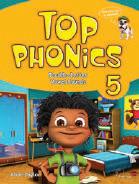




Features
• 5 charming characters who appear throughout all ve books
• Entertaining chants and songs to provide listening and pronunciation practice
• Fun stories to develop reading skills
• Engaging activities to build reading, listening, and writing skills beyond rote practice
• Strategic introduction of sight words to increase reading uency

• Enjoyable review activities at the end of each book
Components
Student Books
- Top Phonics 1 Single-Letter Sounds

- Top Phonics 2 Short Vowel Sounds
- Top Phonics 3 Long Vowel Sounds



- Top Phonics 4 Double-Letter Consonant Sounds













- Top Phonics 5 Double-Letter Vowel Sounds

Workbooks 1-5
Meet the Top Phonics Kids!
Five young children are the main characters of the series. These fun characters appear in each unit and throughout the series. Students will be able to identify with the interests and hobbies of these characters as they encounter them in various situations in the books.



TOP PHONICS
Free Online Program (See p.74)
MP3 Files Tests Answer Keys Flashcards Board Game PPT Teacher’s Guides Downloadable Resources: PHONICS Worksheets 4
[ New Letters and Sounds ]



Introduction to target sounds and words with chants, writing practice, and tracing practice



[


New Words ]
Understanding the letter-sound relationship and vocabulary building

[ Further Practice & On My Own ]

Reinforcing newly acquired knowledge and reviewing words and sounds from earlier units
[ On My Own & Story & Wrap-Up
]
Reading and decoding and a fun song based on the story page




• MP3 Audio QR Code






• QR codes link to online videos
• 8 bonus story cards
• Workbook (sold separately)
Top Phonics 6 is an easy to use review of the essential sounds of English, ideal for young learners who can already recognize and pronounce single letter sounds with con dence. Top Phonics 6 covers a variety of sounds that are introduced in Top Phonics 2, 3, 4, and 5.










• Audio CD included


• 4 stories per book

Top Phonics Readers is a 5-book series developed for young learners who are already familiar with the English alphabet. Top Phonics Readers can be used as a stand-alone reading series, or as a supplement to Seed Learning’s Top Phonics textbook series.






PHONICS Student
Book
Top Phonics 6 Top Phonics Readers 1-5
5
www.seed-learning.com/TK

TOP KIDS
Top Kids is a six-level course for young English language learners. This engaging and instructive course incorporates a systematic double-strand approach to introduce vocabulary and grammar within thematic units graded over six levels.

The double-strand approach to building vocabulary and grammar skills of learners is key to the course. English language learners need to acquire vocabulary in order to comprehend English and participate in classroom discussions, and as well, it is key to reading comprehension. In addition, grammar is central to the teaching and learning of languages as it is the foundation of language.
Top Kids prepares young learners to be able to understand and communicate well in English on a variety of subjects.
Features
• Engaging characters with whom students will identify as they study
• Functional dialogs to demonstrate e ective social behavior for children
• Expansion activities for collaborative and communicative practice

• Graded passages for extensive reading practice
Components
Student Books with MP3 CDs
- Top Kids 1 An Introduction to English


- Top Kids 2 Second Steps in English



- Top Kids 3 Personalizing English



- Top Kids 4 Active English


















- Top Kids 5 Growing with English

- Top Kids 6 Sharing in English
Workbooks 1-6





Free Online Program (See p.74)
MP3 Files Tests Answer Keys PPT Downloadable Resources: Syllabuses Word Lists COURSE
Flashcards Teacher’s Guides ★については下記までお問い合わせください。 Please contact the following regarding ★ E-mail : contact@tryalogue.co.jp ★ ★★ 6
BOOKS
Introduction to target words and language patterns through engaging illustrations and simple text.


Presentation of additional target words for the unit along with speaking focused activities.
Value and citizenship lessons are presented through the series characters. Lessons wrap up with phonics reviews for the lower levels and reading practice for the higher levels.






EXPANSION ACTIVITIES






Odd unit expansion pages present practical classroom language activities along with review of target vocabulary from the unit.
Even unit expansion pages include fiction and nonfiction passages for reading fluency development through extensive reading practice.


COURSE BOOKS
Student Book
7
www.seed-learning.com/FT
Detachable Study Book provides a quick language-learning reference for target expressions, vocabulary, and additional grammar tips.
FAST TRACK
Fast Track is a three-level series designed for young-adult and adult learners of English who have had some exposure to English but need review practice and uency development to become better communicators. Each thematically-organized unit in the series integrates functional language models with skill-based activities. Lessons guide students from speaking together using structured dialogs to engaging in more exible conversations using theme-based sets of questions. Informative readings on topics provide springboards for additional engaging in-class discussion.
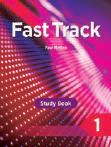



Features
• A multi-skill approach to developing communicative skills while strengthening accuracy and uency skills of learners
• Authentic, conversational dialogs that model language variations to enrich comprehension and production skills
• Interactive and communicative tasks to engage learners while challenging them to stretch their skills
• Model responses to support student completion of all productive speaking and writing tasks
• Fundamental grammar points linked to each unit’s listening and reading samples
• Video and audio recordings with linked tasks for listening comprehension, modeling pronunciation, and developing uency
• Pair-work question sets for fun and exible conversation practice
★については下記までお問い合わせください。
Please contact the following regarding ★ E-mail : contact@tryalogue.co.jp
Unit 1 Nice to meet you. We had a blast! There’s no place like home.
Unit 2 Are you busy? Are you all right? Time waits for no man.
Unit 3 I couldn’t put it down. They’re easy to care for. What should I do?
Unit 4 Money talks! That sounds interesting! I appreciate the o er.
Unit 5 Would you like some? Who’s calling?
Unit 6 Come rain or shine. Are you a people person?
Don’t let me down.
It’s going from bad to worse.
Unit 7 Sooner or later. Welcome to our home. It may be just around the corner.
Unit 8 I’m not from around here Better late than never! Could you say that again?
Unit 9 What do you do? Let’s get cooking. It’s cooked to perfection!
Unit 10 I’ll take it. We’re not so di erent after all. I’m really into it.
Unit 11 You’re like one of the family. I can’t believe it’s late again. It's stated in black and white.
Unit 12 How do I look? You can’t be too careful. I suppose it could be true
MP3 Files COURSE BOOKS
Tests Answer Keys Downloadable Resources: PPT Teacher’s Guides
Fast Track 2 Fast Track 3
Fast Track 1
★★★ 8
Getting Ready
The Warm-up section of the Fast Track series begin with a short listening activity along with various comprehension activities and a guided discussion question to activate basic language that students may already know related to the unit’s theme.
Expressions in Use
A graphic presentation of expressions related to the unit’s theme shows language options for student pairs to practice within a simple substitution-based dialog.
Speaking


Students practice speaking from their own knowledge through listening, note-taking, and sharing. Additional speaking is practiced through creating questions linked to the unit’s theme and language functions.
Role Play
A dialog structured around substituting students’ ideas or information allow for personalization of the language being studied.
Reading
A short passage describing well-known people or current topics help students relate the unit’s theme to today’s world and their personal lives.




Grammar

Each unit concludes with a review of a grammar topic linked to the language that is central to the unit's theme.
Conversation

Variations for the language functions related to the unit theme are presented in a listening task that targets modeling and pronunciation. Students are then encouraged to creatively adapt the dialog with suggested expressions or their own ideas.

Sounds Fun
Short video dialogs are presented in repeated sequences. Variations in the sequence remove subtitles and/or audio for students to practice from memory.


















Pair Work




An extensive list of discussion questions are included in each unit. After writing their own ideas to answer the questions, students practice a semi-guided conversation using the questions to interview each other.

A short comprehension activity reinforces informative content from the reading passage. This is followed by a discussion topic supported with images to stimulate student responses.

COURSE BOOKS Nice to meet you. Unit 1 Getting Ready 1 Work with classmate. Make short dialog using the above expressions. Act it out. A: Hi there. B: Expressions in Use 2 A When can you use the given expressions? Check the places. at party Allow me to introduce myself. How’ve you been? 3. Pleased to meet you. 4. Long time, no see. 5. My name is but you can call me A Think about these questions and share your ideas with the class. When would you use casual greeting in English? When would you use formal greeting in English? Listen to these common words and expressions used when speaking. Hey! How’ve you been? I’m hanging in there. What’s up? Long time no see. Got it. Same old same old. What’ve you been up to? It’s pleasure to meet you. Look at the pictures. Fill in the blanks using words and expressions from B. Then listen to 1. A: Gloria! see! 2. A: You Parker: Hi. Morgan: Hi. I’m Morgan. Morgan Harris. My name is Parker Leeds. Parker. Parker: It’s nice to meet you, too. Morgan: What’s your last name again? Parker: It’s Leeds. L-E-E-D-S. Morgan: Leeds. Got it. B Practice the conversation with a partner. Use these expressions in the conversation above or use your own ideas. Conversation 3 A: Hello. B: Hey. My name’s Chance. B: It’s nice to meet you, Chance. My name’s Ty. A: Glad to meet you. How do you spell your name? Uh. It’s spelled T-Y. It’s short for Tyler. see. Glad to meet you. B Repeat after the audio. C Watch and say the assigned role. 1. You are B: 2. You are A: Sounds Fun 4 Glad to meet you. How do you do? Morning! How’s going? Pleased to meet you. It’s pleasure. What did you say your last name is?
Fill in the missing words in the dialog. Then listen and check your answers. Siobhan: Hi there. Paul: Hi. Paul: Yeah. think I’m really lost. I’m for Room 118. Siobhan: This old school can be so confusing. can show you that Siobhan: Are you here? Uh, yeah, today’s my day of class. Oh! Welcome to the academy. My Now listen to the rest of the conversation. Then answer the questions. What does Paul say about Siobhan’s name? 2. Where is the room that Paul is looking for? Work with partner. One person reads a response. The other person makes question for the 1. It is spelled R-E-I-D. My name Lee. I’m ne, thanks. 4. Yes, I’m new here. No, don’t know Bill. D Change roles. Introduce yourself and nd out your partner knows certain person. B: Hi there. My name What your name? My name A: It’s nice to meet you, Nice to meet you, too. Are you new here? B: Yes, am. Then you probably don’t know Let me introduce you. Speaking 5 Role Play 6 What’s your last name? My last name Carter. How do you spell your rst name? Aren’t you from New York? 4. What something you like to do? 5. there one place you usually do that? Yes, there is. usually read in my room. 6. What kind of music do you like? like classical music. 7. What your favorite thing to do on weekends? like to meet up with my friends. Where do you do that? We hang out in co ee shops. Read the questions and sample answers on this page and on page 102. Then write your own answer to each question. Work with partner. One person should use this page. The other person should use page 102. Take turns asking and answering questions. Pair Work 7 Questions Set A
A Read about some famous people. Reading 8 Famous People Hi! My name is Cameron. Today I’m going to tell you a little bit about myself. am from San Diego. My favorite thing to do is to go snowboarding. love zipping down snow-covered mountain. also like to be outside. For me, snowboarding is exciting and relaxing. Now you know a few things about me. Thanks for letting me share. Hey everyone! My name is Emma. Allow me to share something about myself with you all. am from Oxfordshire, England. My favorite thing to do is to dance. love modern dancing and break dancing. also like playing tennis. When want to relax, take art classes. That’s all wanted to share. hope you enjoyed hearing about what like to do. Emma Watson Hello. My name is Justin. My family name is Bieber. You spell that B-I-E-B-E-R. I’m from Stratford in Canada. My favorite things to do are to listen to music and skateboard. Both of those are fun and relaxing for me. like playing video games, too. One of my favorite games is Halo That is a little about me. Thanks for your Justin Bieber B Check one or more boxes for each question below. Who enjoys 1. riding something? 2. turning on music to enjoy free time? playing game outdoors? Who likes to relax through sport? to make something to relax? 6. to relax by hearing great songs? What is your favorite thing to do? Tell a partner. Now tell your partner something about yourself as in the reading passage. My favorite thing to do When want to relax, Nice to meet you.
Grammar 9 Learn the grammar. B Write the correct words in the blanks. 1. What your name? 2. My family name Reed. This old school building can confusing. 5. My favorite things to do to listen to music and skateboard. 6. Both of these fun and relaxing for me. glad to in this class together with you all. am like like classical music. meeting you. You probably know Jane. 4. don’t really using social media. 5. How do you spell spelled your name? enjoy walking with my sister. We hang out hangs out in co ee shops. 9. like to take a walk to relax relaxing). 10. love zip zipping fast down a mountain. Choosing the correct form of be Functions of verbs As the main verb in sentence: … He/She/It is… You/We/They It can be… You must be… They should be After dummy or empty subjects: … There After adjectives, in the in nitive form: am happy … good As the main verb in a sentence: like… He/She enjoys You/We/They As part of imperative suggestions: As gerunds or in nitives after like, love, enjoy enjoy playing… He/She loves going They like After adjectives, in the in nitive form: am happy to play Critical Thinking 11 Writing 10 Project: Prepare a short presentation as above to introduce yourself to the class. Study the writing example. Then ll in the blanks with the correct information. Analyze: Look back through the unit for expressions used for meeting and greeting others. List the expressions you have learned as formal or informal. B Evaluate: Share your ideas with the class. Does everyone agree about which expressions are Hi! My name is Emily Today I’m going to tell you little bit about myself. was born in Toronto love Canada My favorite thing to do after school is singingpopsongs tojogforexercise Now you know few things about me. Thanks for letting me share. London England Webb puzzle games to play video games watching movies Hello. My name Jacob. My family name is My favorite thing to do after school is really like playing also love It’s very nice to meet all of you. I’m glad to be in this class together with you all. Formal Expressions Informal Expressions
& Critical Thinking
Writing
Writing models and a Critical Thinking task support students in creating short presentations to give for the class.
9
Student Book
www.seed-learning.com/EFR

























EASY FUN READING
Level: Beginning






Easy Fun Reading is a three-level series devised for emergent students of English who are beginning to move from the learning-to-read stage into the reading-to-learn stage. Easy Fun Reading is designed to set a foundation in reading in order to prepare students for future study of academic material in English. The series also utilizes a four-strand approach that provides the framework for students to practice receptive and productive skills alongside focused language study and uency practice.
Features



• Graded reading passages


















• Word recognition activities to stimulate reading uency


• High-frequency sentence patterns to highlight useful grammatical structures


• Review units with activities and games to reinforce vocabulary acquisition

• Fun illustrations and images that aid in comprehension and retention




• Pull-out full-color workbook included



10
Free Online Program (See p.74) READING Very Eas Fun Reading Liana Robinson AudioCD 1 Easy Very Eas Fun Reading 2 Easy Liana Robinson Very Eas Fun Reading Liana Robinson 3 Easy Liana Robinson
MP3 Files Tests Answer Keys PPT Downloadable Resources: Syllabuses Word Lists
15-20 words 20-25 words25-35 words
New Words
Lists key vocabulary along with illustrations that provide visual definitions for the words. An audio recording of the words is available.

Word Watch




Presents a quick seek-and-find word recognition activity to focus students on highfrequency words found in the passage.




Check It

Includes two to three reading comprehension questions related to the unit’s reading passage.




Learn It
Reinforces the unit’s target vocabulary through visual recognition and written practice.









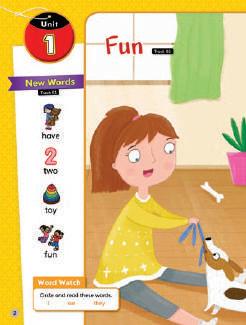
Student Book Workbook
Workbook
Provides extra vocabulary reinforcement, reading fluency drills, and basic writing practice that can be completed as homework.
Reading
Presents a simple, fun original passage using grammar structures and vocabulary easy for beginner students. An audio recording of each passage is available.


Say It
Practices speaking and reading comprehension while reinforcing key sentence structures. Here, students match written information with images selected to review the unit’s new words.
Know It
Practices listening comprehension by having students match aural information with images selected to review the unit’s target vocabulary and key concepts.
READING
11
www.seed-learning.com/FR






FUN READING
Level: High-Beginning
Fun Reading is a three-level series designed for elementary students of English who are moving from the learning-toread stage into the reading-to-learn stage. Fun Reading incorporates short and simple ction and non- ction texts to support students in developing fundamental readings skills required for future study of academic material in English. Strict vocabulary control of all passages and activities allows students to gradually accumulate new vocabulary while practicing learned items from previous units.






Features


• Graded ction and non- ction reading passages



• Pre-reading questions to stimulate interest and background knowledge
• Fun seek-and- nd questions that ask students to carefully consider illustrations and photos
• Review units with activities and games to reinforce vocabulary acquisition








• Pull-out full-color workbook included



Free Online Program (See p.74)
MP3 Files Tests Answer Keys PPT Downloadable Resources: Syllabuses Word Lists READING 35-45 words 45-55 words55-65 words
Student Book
Words to Know
Lists key vocabulary along with illustrations that provide visual definitions for the words.










Find It!
Presents a quick seekand-find activity to focus students on details of the unit’s main illustration or photo.

READING
Warm Up
Uses a key question to stimulate students’ interest in the unit topic.
Reading
Presents a simple, fun, original story using grammar structures and vocabulary familiar to high-beginning students. An audio recording of each passage is available.
After Reading

Reading Comprehension Includes three comprehension questions related to the unit’s reading passage.
Summarizing








Reinforces the unit’s target vocabulary and passage content through various types of summary activities.


Workbook



Practice It
Listening
Practices listening comprehension by having students match aural information with images selected to review the unit’s target vocabulary.
Vocabulary Consolidation Highlights the target vocabulary of the unit along with previously studied vocabulary items within the series.
Provides extra vocabulary reinforcement, reading fluency drills, and basic writing practice that can be completed as homework.



13
www.seed-learning.com/EFF





































EASY FUN FACTS

Level: Beginning











Easy Fun Facts is a three-level series designed for elementary students of English who are being taught comprehension skills in the reading-to-learn stage. Easy Fun Facts exclusively focuses on non ction texts to equip students for future study of academic material in English. The series also utilizes a fourstrand approach that sets a foundation for students to practice receptive and productive skills alongside focused language study and uency practice.
Features








• Graded non ction reading passages that are informative and accessible for entry-level students
• Pre-reading questions to stimulate interest and background knowledge

• Sight word practice to increase recognition and reading uency


• Quick tasks to practice scanning skills with each passage















































• Review units with activities and games to reinforce vocabulary acquisition

• Pull-out full-color workbook included







14
Free Online Program (See p.74)
MP3 Files Tests Answer Keys PPT Downloadable Resources: Syllabuses Word Lists READING Liana Robinson AudioCD
Non ction Reading Builder
LianaRobinson
Non ction R d ng Builder Liana Robinson 3 Non ction R d ng Builder Liana Robinson Liana Robinson 25-35 words
LanaRobinson
35-45 words45-55 words
Key Words














Provides a visual dictionary for the four key vocabulary words. An audio recording of the words is available.








































Think
Uses a key question to stimulate students’ interest in the unit topic.
Read and Answer
Includes three comprehension questions related to the unit’s reading passage.
Say and Choose
Reinforces the unit’s target vocabulary through an oral practice and visual recognition activity.






Student Book Workbook

Sight Words

Highlights three sight words that appear in the unit’s passage.





Reading
Presents an easy, fun original passage using grammar structures and vocabulary designed for entry-level students. An audio recording of each passage is available.




Check It

Asks students to scan the passage and/or image to find key points in preparation for answering reading comprehension questions on the next page of the unit.
Match and Write



Highlights the target vocabulary of the unit along with key grammar structures for focused language practice.


Show and Tell
Supports basic speaking practice through simple substitution drills with a partner.












Provides extra vocabulary reinforcement, reading fluency drills, and basic writing practice that can be completed as homework.


READING Track 18 Two, Four, Six, More! Unit animals ant crab none Key Words Think How many legs do you have? 40 Track 19 but legs four Sight Words Some animals have four legs. Cats and dogs have four legs. Some animals have six legs. Bugs like ants have six legs. Spiders have eight legs. Crabs have ten legs. But worms have none! Poor worms. 41 Check It Check the crab’s legs. 1 This reading is about a. legs b. arms 2 Some have four legs. a. b. 3 Bugs like have six legs. b. ants 1 none 3 ant 2 animals 4 crab Read and choose the correct answers. Check ( ) the correct pictures. a b a b a b a b Read and Answer Say and Choose 42 1 Some have legs. 2 Bugs like have b legs. 3 have ! 4 But have d legs. Talk about how many legs. Read, match, and write. Match and Write Show and Tell How many legs does a cat have? 1 I have 2 legs. 3 It has 4 legs. How about you? 2 43 a c b Draw your idea. d 4 6 8 9 Unit 1 Some have four legs. 2 Bugs like have six legs. 3 have ten legs. 4 But worms have Match and say. Read and write. Word Review Writing Practice 20 Two, Four, Six, More! 1 4 2 5 3 6 artist museum none ant crab animals 1 four legs. Cats and dogs / have 2 animals have six legs. Some 3 have none! / Poor worms. / But worms Unscramble and write. Check ) the correct answers. Reading Fluency Wrap Up 21 1 Bugs like ants have eight legs. b Bugs like ants have six legs. 2 A worm has no legs. b A worm has ten legs. Workbook How many legs does a spider have?
15
FUN FACTS




Level: High-Beginning
Fun Facts is a three-level series designed for elementary students of English who are seeking to develop their comprehension skills in the reading-to-learn stage. Fun Facts exclusively focuses on non ction texts to prepare students for future study of academic material in English. The series also utilizes a fourstrand approach that sets a foundation for students to practice receptive and productive skills alongside focused language study and uency practice.


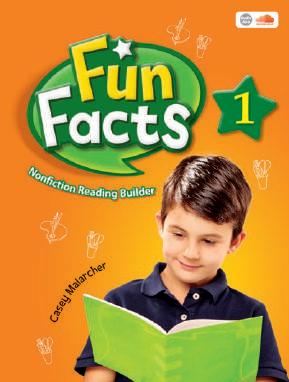
Features





• Graded non ction reading passages that are informative and accessible for high-beginning students
• Pre-reading questions to stimulate interest and background knowledge



• Key Structure notes to highlight useful grammatical structures



• Check It tasks to practice scanning skills with each passage

• Pull-out full-color workbook included




www.seed-learning.com/FF Free Online Program (See p.74)
MP3 Files Answer Keys Tests PPT Downloadable Resources: Syllabuses Word Lists READING
16
55-60 words 60-65 words65-75 words
READING
Key Structures
Key Words









Lists key vocabulary along with illustrations that provide visual definitions for the words.





Think
Uses a key question to stimulate students’ interest in the unit topic.
Check It
Highlights one to three grammatical structures that appear in the unit’s passage.








Reading
Presents a simple, interesting reading passage using grammar structures and vocabulary familiar to high-beginning students. An audio recording of each passage is available.

Asks students to scan the passage to find key points in preparation for answering reading comprehension questions on the next page of the unit.
Read and Answer
Includes three comprehension questions related to the unit’s reading passage.
Say and Choose
Student Book Workbook
Reinforces the unit’s target vocabulary through an oral practice and visual recognition activity.
Provides extra vocabulary reinforcement, reading fluency drills, and basic writing practice that can be completed as homework.


Match and Write
Reviews the target vocabulary of the unit along with key grammar structures for focused language practice.
Show and Tell
Supports basic speaking practice through simple substitution drills with a partner.



17
www.seed-learning.com/TRFF

TIMED READING FOR FLUENCY
Level: High-Beginning to Intermediate
Timed Reading for Fluency is a useful series for students who want to develop their reading uency. Because uency development requires students to make the best use of what they already know, the reading passages in this series target familiar vocabulary and grammar. Such reading material allows students to practice recognizing and processing texts that they read without undue struggle while aiming toward a faster reading speed. This series of books uses timed readings of standard lengths so that students can track their progress throughout the course.




Features
• Reading texts developed within controlled vocabulary and grammar guidelines
– Timed Reading for Fluency 1: 200 word passages with 800 headwords






– Timed Reading for Fluency 2: 275 word passages with 1100 headwords

– Timed Reading for Fluency 3: 350 word passages with 1500 headwords
– Timed Reading for Fluency 4: 400 word passages with 2000 headwords
• Thematically organized chapters that help students focus on subject-speci c content and language
• Chapter preview pages to familiarize students with key vocabulary and proper nouns found in the chapter’s reading passages
• Reading speed charts at the back of each book for students to record their comprehension question score and reading speed for each passage
• Audio recordings of all passages for supplementary listening

• Downloadable answer key



Downloadable Resources:

18
MP3 Files Answer Keys
Word Lists READING
Tests
★
Reading at a reasonable speed, or reading uently, is an important goal for second language learners. This series of books uses timed readings. Students should aim to increase their speed until it gets close to 250 words per minute.
Paul Nation Professor of Global English Education
★については下記までお問い合わせください。 Please contact the following regarding ★ E-mail : contact@tryalogue.co.jp
Student Book
Chapter
• Each book consists of eight themes (chapters); each chapter consists of five passages.








• Introductory pages expose students to concepts and key vocabulary found in the chapter.
• At the end of the introductory pages, students can find a list of proper nouns appearing in the chapter’s passages.
Reading Comprehension

Reading
Passages always appear on right facing pages so that students can focus on reading without the distraction of other related texts.
Time
Each passages is followed by a place to record time spent reading. These times can be charted in the Speed Reading Chart at the back of the book.
Word Count








All passages in a book are written to a standard length to facilitate analysis of one’s reading speed.

Reading Speed Chart











Students should target a reading speed of 250 wpm (words per minute). By charting their reading speed for di erent passages using the charts at the back of each book, students can better understand how well they read at present and how much they need to improve. The four levels of Timed Reading for Fluency can provide e ective practice for students at any level.
Comprehension questions always appear on left facing pages so that students can check how much they understood from their reading without looking at the passage.
Extra Practice
An additional activity targeting useful vocabulary items encountered in the lesson’s reading passage follows each passage’s set of comprehension questions.
• Minimal suggested reading speeds for various tests:
IELTS® 150 wpm
























TOEFL® 200 wpm








READING Extra Practice: Vocabulary Comprehension Questions Circle the right answer. 1. This reading is about: how dangerous car racing is. b. a sport that uses cars. building a race car. 2. The writer says that: racing on the streets is dangerous. b. racing on a closed track is not popular. racing cars is an expensive sport. 3. The rst race cars only went: about 24 km/h. b. about 375 km/h. about 4 km/h. 4. Which of the following is NOT part of the fastest race cars? A seat b. Windows Tires 5. In order to race, a driver must: be in good health for a race. b. not drink water before or during a race. drive with another person in the car. Score Circle True or False for each sentence. 1. The rst car race was in Germany. True False 2. The rst cars went less than 30 km/h. True False 3. Today, cars can race at over 300 km/h. True False 4. The fastest race cars have no seats or windows. True False 5. Today, race cars only need to change their tires after races. True False 82 Chapter 7: Sports Reading31 Start Your Engines! Motorsports are full of fast cars and fun! The sport of racing cars has a long history. People used to race cars on the roads from town to town. Car races started in the 1890s, and the rst car race was in France. After that, people began to race their cars in other places, too. Racing cars on the road was very dangerous. People soon created closed tracks so cars could race there without any problems. The rst race cars were not very fast. They only went about 24 km/h. But some cars today can go as fast as 375 km/h. The fastest cars are special kinds of race cars. They have only one seat, large tires, and no windows. The engine for the car is behind the driver, and the racing team has to build the car by themselves. These cars race very fast. Many cars have their tires changed two or three times during the race. Drivers need to be strong and in good health to race, so they must exercise. They drink a lot of water before they race because the cars get very hot. Drivers can lose about 4 kg of water during a race. Word Count 200 words Time Reading 31: Start Your Engines! 81
Chapter7 1. Racing: 2. Taekwondo: 3. Cup Stacking: 4. Gaming: A Match two (2) phrases with each sport. play an electronic sport b. drive a car need an engine d. kick and hit e. like stacking blocks f. use a computer g. need skill to stack quickly h. learn skills to protect yourself Sports Chapter 7: Sports 79 B Write the right word in each blank. Two (2) words will not be used. better electronic protect ready rules socks team stack C Answer these questions. Then ask your classmates. Can you nd another person who has the same answers as you? Name of other student 1. A boring sport to watch is 2. A team sport that sometimes enjoy is 3. don’t know the rules of 4. A fun electronic game have played is Study these words that you will nd in the readings for this chapter. Proper Nouns to Know France Korea University of California, Irvine Some people who do sports put on special 1. or touch their hats as they get 2. to play. They believe these things help them do 3. at their sport! All sports have 4. that players must follow, whether the player does the sport alone or on a 5. The rules are there to 6. all of the players. 1. 3. horse 5. rule 2. 4. stacking 6. team D Find the right word in the box to add to the given words. Write the sports phrases below. blocks book captain engine racing socks 80 Chapter 7: Sports
Reading Speed Chart Write your score for each reading passage at the bottom of the chart. Then put an X in one of the boxes above the reading passage number to mark your time for each passage. Look on the right 112
19
www.seed-learning.com/RAW





READING FOR THE ACADEMIC WORLD

















Level: High-Intermediate to Advanced



Reading for the Academic World is a three-book series designed for students who are seeking to develop their academic reading skills with particular focus on passages that incorporate items from the Academic Word List. Reading for the Academic World provides students with a range of informative texts from various academic elds including history, natural science, literature, social issue, psychology, business, linguistics, and more. All passages in the series are supported with activities to provide opportunities for students to practice comprehension of input, re nement of output, uency with current skills, and languagefocused learning.



Features


• Reading passages developed to target exposure and practice of more than 500 words from the Academic Word List
• Thematically organized paired readings covering a broad range of academic topics
• Comprehension activities that include question types commonly found on standardized test of English

• Vocabulary development activities to reinforce items presented from the Academic Word List

• Language extension activities to practice grammar structures and paraphrasing

• Audio recordings of reading passages








































MP3 Files Downloadable Resources: Word Lists READING Free Online Program (See p.74) Tests PPT ★については下記までお問い合わせください。
contact the following regarding ★ E-mail : contact@tryalogue.co.jp ★ 20
Please
Student Book

Pre-Reading Questions


Three questions prepare students for the unit reading by asking them to think about their experiences or opinions in connection with the topic of the unit’s passage.
Vocabulary Preview














Not Just One Way
Twelve words from the Academic Word List are highlighted in each passage of the series. Simple definitions reflecting usage of the words in the unit’s passage are provided in a pre-reading activity.


Topic at a Glance
Before each unit’s passage, students will read a short paragraph commenting on the focus of the reading.
Readings
The three levels in the series present informative academic passages of 600, 700, or 800 words. Footnotes for each passage provide additional vocabulary support for students.

Reading Comprehension

Multiple-choice questions after each passage focus on common question types for tests of English reading.
Language Focus


A particular grammar structure found in the reading passage is reviewed and practiced in each unit.
Vocabulary Reinforcement
Two activities reinforce the twelve vocabulary items highlighted in the unit. One activity practices usage of the words in a related but new context. The second activity focuses on common collocations incorporating the target vocabulary.
Paraphrasing Practice
Students read sample paraphrases to match with content from the reading passage.
Vocabulary Extension








A variety of tasks help students extend their knowledge of academic words.

READING Think about the following questions. 1. What other language would you like to be able to speak? 2. What do you nd di cult about learning English? 3. What advice would you give to someone beginning to learn another language? Pre-reading Questions
Vocabulary Preview Write the word that matches the de nition. 1. a basic truth or guiding rule 2. directed at seeing one part or a certain part 3. something put in for use or analysis 4. working hard because of a strong desire or clear reason 5. arranged in levels, grades, or ordered positions adj. 6. the end result that one seeks to reach 7. one part or unit of a list or group 8. something made or given out as a result 9. the expected or assigned duty of something 10. to require for use; to include as a necessary part 11. the method used to perform a task 12. the study of something’s parts to understand how the parts relate analysis focused graded input motivated output principle involve goal item role technique Unit 1: Not Just One Way 9 Unit 1 Language Not all English teachers use the same teaching 1. even when they present lessons of similar content guided by the same principles of language learning. For example, consider two teachers working with 2. readers in their classrooms. A key principle guiding both teachers may be connecting language instruction with what the students already know in their rst language. However, one teacher’s technique may 3. in-class reading practice with the teacher in the role of providing 4. for students. The other teacher might ask students to read at home and then come to class ready to talk about the story. The 5. in this case is for the teacher to listen to the students in class and focus on key items in the 6. spoken by students to improve their English. Vocabulary Reinforcement A. Complete the passage using the given words. Three (3) words will not be used. analysis focused goal graded input involve motivated output techniques B. Fill in the blanks with the correct phrases. Three (3) phrases will NOT be used. 1. All of the students in the class seemed 2. Sleep plays in studying and learning. 3. Our teacher showed us for memorizing words in class. You can’t buy from the bookstore near the school, but you can get them online. 5. The program gives good results, but is not easy for new users to read and understand. a good technique graded readers highly motivated key principle an important role for further analysis the printed output meaning-focused input 14 Language vocabulary (n.) — all the words one knows uency (n.) — ease of ability in skill such as speaking, writing, etc. extensive (adj.) — wide; broad Topic at a Glance Most students are required to study some kind of foreign language in high school. As students get older, they often choose to continue their studies or even choose to study additional languages. Individuals and school programs follow a wide variety of ways to teach foreign languages. Have any of these ways to learn proven to be better than others? A number of factors can a ect how well one way to learn works over another, but there are a few language learning principles that can certainly help just about any student. How to Learn a Foreign Language There are four principles that are useful to follow when you learn a foreign language. Principle 1 Work out what your needs are and learn what is most useful for you Principle 2 Balance your learning Principle 3 Apply conditions and techniques that help learning Principle 4 Keep motivated and work hard Needs Part of deciding what you need to learn involves needs analysis You need to be clear why you are learning the language. If speaking the language is your main goal you need to get some help on pronouncing the language early in your study of the language. If reading is your main goal, study vocabulary and read a lot. Choose books that are the right level for you, particularly books or stories that have some but not too many unknown words for you. Balancing learning You need to spend equal amounts of time on each of four kinds of practice: 1 learning from meaning-focused input (listening and reading) 2 learning from meaning-focused output (speaking and writing) 3 language-focused learning (studying pronunciation, vocabulary, grammar etc) 4 uency development (getting good at using what you already know) Techniques and conditions There are some very useful language learning techniques that you should use and you need to understand how to use these techniques well and in the right balance. These techniques include extensive reading, using word cards, speed reading, prepared talks, and extensive listening. Language 10 Language repetition (n.) — doing the same thing again If you like using a tablet or cell phone, nd a good ash card program for doing your word card learning. Or you can make small cards with the foreign word or phrase on one side and the translation on the other. Get a movie that you like in the foreign language and nd the script for it online. Watch parts of the movie many times while studying the script. Copy and repeat useful phrases and sentences until you remember them and are happy with your pronunciation. There are books specially prepared for learners of English called graded readers. When you have read a graded reader carefully, read it again but more quickly. Do lots of easy reading every week, at least twenty minutes each day if possible. Try to arrange a regular speaking time with a native speaker, either face-to-face or online. Practice useful role plays of common situations, such as saying hello and goodbye to people, buying things in a shop, asking for help, and asking directions. Repeat these role plays several times so they can be done uently. Keep a list of them so they can be practiced again and varied over several weeks. Learn useful phrases and sentences as whole units but also make sure you understand their parts and how they together. Understanding the parts makes the whole phrase or sentence easier to remember. Spend some time regularly studying and practicing pronunciation, if possible with a teacher who understands about the sounds of the language. This is very important if you are learning a language which uses very di erent sounds from your rst language. The two most important conditions supporting learning are spaced repetition and the quality of attention given to items Quality is increased by recalling what you have met, making varied recalls, analyzing language items, and giving focused attention to them. Hard work Learning a language involves a lot of work and even the most skilled language learners must devote time and energy to learning a language. Be prepared to work hard, practice regularly and keep your motivation high by noting your successes in using the language and in increasing your language knowledge. Set regular weekly goals for words to learn, pages to read, and minutes to spend doing listening. Keep a record of what you do so you can see your progress. Un 1 Language Unit 1: Not Just One Way 11 Reading Comprehension Choose the best answer. 1. Balancing your learning involves choosing the type of language practice that is the most important for you. b. spreading learning across the four skills of listening, speaking, reading and writing. giving equal time to each of four types of language learning practices. d. doing lots of meaning-focused learning. 2. What is included in language-focused learning? Study of parts of the language b. Doing plenty of reading c. Concentrating on English d. Getting good at what you already know 3. Why does extensive reading usually involve graded readers? a. Because you should do extensive reading each day. b. Because they include only be a small number of unknown words. Because there needs to be plenty of repetition in order to remember words. d. Because it is one of the four important language learning practices. 4. What should you do when you want to learn phrases and sentences? Study them through input, output, uency practice, and language-focused learning b. Use graded readers c. Choose books that are the right level for you d. Analyze their parts Paraphrasing Practice Find the sentence(s) from the indicated paragraph that means the same as the given sentence. Copy the sentence(s) from the paragraph. 1. Paragraph 2 You should think about why learning a language is important or necessary for you when you are considering what to study. 2. Paragraph 7 After you nish studying a graded reader, try re-reading it faster. 12 Language Vocabulary Extension The following words from the passage are divided into group by frequency that the wor ds appear in a corpus of English. 1. Which list has the most words you don’t know? 2. Create your own set of word-study cards by writing words you don’t know on one side and that word in your rst language on the other side. Use these cards to learn the words. 3. Find the words on your word cards in the reading passage for this unit. Look at the phrases and sentences where those words appear. Language Focus Parallel structure in a sentence means that words, phrases, or clauses have the same form. Quality is increased by recalling what you have met, making varied recalls, analyzing language items, and giving focused attention to them. Set regular weekly goals for words to learn pages to read and minutes to spend doing listening. Circle the part of each sentence that is NOT parallel. Then suggest a way to revise the sentence to give it parallel structure. 1. Learners need to master reading, writing, speaking, and to listen whether they study English, Spanish, Japanese, or some other language. 2. Graded readers are useful for improving your reading comprehension, how fast you read, and your vocabulary recognition. 3. Phrases are built from words, clauses are built from phrases, and phrases and clauses make sentences. 4. Working with a native speaker can help language learners understand correct pronunciation when speaking, how to respond when things are said, and how to act when words are not used. Words Among First 750Words Among 750-1500 Words Above 1500 hard understand spend mean sound already clear either include support until language practice prepare common decide record page special quick space goal grade unit repeat direction principle focus foreign regular balance condition involve role attention increase quality amount analyze apply development equal least analysis output vary academy copy etc. native otherwise progress speed target technique pronounce recall web arrange ash translate Unit 1: Not Just One Way 13 Un 1 Language
21
www.seed-learning.com/CRF

CULTURE READERS: FOODS
Level: High Beginner to Low Intermediate
Series Editor: Anne Taylor
Seed Learning’s Culture Readers: Foods is a new non ction series that explores foods and culinary traditions around the world. The series explains dishes that are central to the cuisine of various nations while looking at important aspects of these foods. Readers will get a glimpse into the history of how people began eating certain foods and the customs that surround these foods. In particular, the series aims to broaden the perspective of learners who may have limited exposure to other cultures by presenting positive and accurate portraits of foods and traditions around the world.
Features
• Provide informative descriptions of what people eat around the world and how these foods came into being



• Allow learners to develop their reading uency through extensive reading practice
• Present strictly controlled vocabulary over the graded levels of the series
• Include comprehension questions in each reader to encourage learner accountability
• Highlight both subject-speci c and level-appropriate terms in succinct glossary pages
• Provide menus consisting of foods that appeared in the reading and more
• Suggest additional words to use when discussing the foods introduced in each reader

Levels 1 2 3 4 Base Vocabulary 500 750 1000 1250 Word Count 400 600 800 1000 ERF Scale High Beginner Elementary Early Intermediate CEFR A1 A2 B1
READERS MP3 Files Downloadable Resources: Activity Pack PPT
Video Supplements Available on YouTube Lesson Plans 22
Levels and Content



































Why is learning about food and culture important?

















































































































“The exchange of food is the exchange of culture, and thus understanding a place’s food can be an incredible insight into their culture and lifestyle.”









- Marvin Harris (American anthropologist and author)







“A people without the knowledge of their past history, origin and culture is like a tree without roots.”


















- Marcus Garvey (Political Activist, Journalist, and Orator)

5 Foods from Spain 4 Foods from Mexico 3 Foods from South Korea 2 Foods from Italy LEVEL 1 1 Foods from India Level 1 - 1 Foods from India Delicious Indian Food I It is a very large country! It has over 137 million people. India 3,214 km 5 Foods from South Africa 4 Foods from France 3 Foods from England 2 Foods from China LEVEL 2 1 Foods from the United States Level 2 - 1 Foods from the United States Fun Facts about the United States map of the USA The United States of America (US or USA) is a very large country. It goes all the way from the Pacific to the Atlantic Ocean. It is made up of fi states, so the flag has fi y stars on it. The flag is red, white, and blue. 5 Foods from Turkey 4 Foods from Thailand 3 Foods from Morocco 2 Foods from Japan LEVEL 3 1 Foods from Germany Level 3 - 1 Foods from Germany Famous German Food Germany is a large country in Europe. It has over 80 million people! It is famous for its castles. It has more than 2,100 castles! Berlin is the capital city. map of Europe 5 Foods from Vietnam 4 Foods from Russia 3 Foods from Greece 2 Foods from Brazil LEVEL 4 1 Foods from Australia Level 4 - 1 Foods from Australia All About Australia A country. It is in the middle of the Pacific Ocean and the Indian Ocean. It is the sixth largest country in the world. Almost 26 million people live here! Australia is special for many reasons. It is a country READERS
23
www.seed-learning.com/CRH
CULTURE READERS: HOLIDAYS
Level: Low-Beginning
Series Editor: Kelly Daniels
Seed Learning’s Culture Readers: Holidays is a new non ction series that explores holidays and festivals celebrated around the world. The series explains important aspects of these holidays including when they are celebrated, how they began, and what people do for them. Readers will gain a better understanding of the history and beliefs of di erent cultures as they learn about dates and times of the year designated for celebrations worldwide. In particular, the series aims to broaden the perspective of learners who may have limited exposure to other cultures by presenting positive and accurate portraits of customs and traditions around the world.
Features
• Provide informative descriptions of how people celebrate cultural or religious holidays and festivals

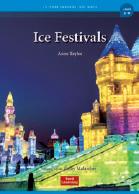
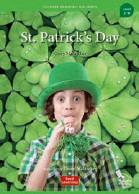

• Allow learners to develop their reading uency through extensive reading practice
• Present strictly controlled vocabulary over the graded levels of the series
• Include comprehension questions in each reader to encourage learner accountability
• Highlight both subject-speci c and level-appropriate terms in succinct glossary pages
• Suggest additional topics for students to research and discuss on “Teachers’ Notes” pages

Levels 1 2 3 4 Base Vocabulary 500 750 1000 1250 Word Count 400 600 800 1000 ERF Scale High Beginner Elementary Early Intermediate CEFR A1 A2 B1
READERS MP3 Files Downloadable Resources: Activity Pack PPT Video Supplements Available on YouTube Lesson Plans
24
Levels and Content





















































What is culture?













”Culture is the way we live. It is the clothes we wear, the foods we eat, the language we speak, the stories we tell, and the ways we celebrate. It is the way we show our imaginations through art, music, and writing.”

- Bobbie Kalman (Author, Educator, and Psychologist)







































Why is learning about other cultures important?






























”A people without the knowledge of their past history, origin and culture is like a tree without roots.”































- Marcus Garvey (Political Activist, Journalist, and Orator)



“The beauty of the world lies in the diversity of its people.”












- Unknown







5 Thanksgiving Day 4 La Tomatina 3 Easter 2 Chinese New Year LEVEL 1 1 Valentine’s Day Level 1 - 1 Valentine’s Day A Holiday for Love Valentine’s Day is a well-known holiday. This holiday is on February 14 5 Halloween 4 St. Patrick’s Day 3 New Year’s Day 2 The Lantern Festival LEVEL 2 1 Holi Level 2 - 1 Holi A Spring Celebration Holi is a fun Hindu festival. It is at the start of spring. It celebrates the end of winter and the start of spring. The end of winter The start of spring The Hindu god Ganesha 5 Ice Festivals 4 Christmas 3 Oktoberfest 2 The Dragon Boat Festival LEVEL 3 1 Eid al-Fitr Level 3 - 1 Eid al-Fitr 30 Hungry Days Eid al-Fitr is a holiday for people whose religion is Islam. People who believe in Islam are called Muslims. Every year, Muslims have a special month. This month is Ramadan. 5
4
3
LEVEL 4
Level 4 - 1 Guy Fawkes Day Remember, Remember the 5 of November I you are in Great Britain in the fall, you might hear these words: “Remember, remember the 5 of November. Gunpowder, treason, and plot! know no reason why gunpowder and treason Should ever be forgot!” Don’t forget this important date. location of Great Britain.
Hanukkah
Songkran
Carnival 2
The Naadam Festival
1 Guy Fawkes Day
READERS
25
www.seed-learning.com/FJR
FUTURE JOBS READERS

Level: High-Beginning
Series Editor: Casey Malarcher
Seed Learning’s Future Jobs Readers is a new non ction series that explores exciting new careers that may soon become available to young people today. The series explains the type of work these careers will entail along with the kind of study and experience they require. Many of the careers that the series focuses on relate to developing technologies with applications in many di erent elds. In particular, the series aims to spark the interest of readers in considering the study of STEM-related subject areas that can open up new horizons for the next generation in the workplace.
Features


• Provide informative descriptions of what people do in various careers along with basic requirements for entering certain elds


• Allow learners to develop their reading uency through extensive reading practice
• Present strictly controlled vocabulary over the graded levels of the series

• Include comprehension questions in each reader to encourage learner accountability
• Highlight both subject-speci c and level-appropriate terms in succinct glossary pages
• Suggest additional topics for students to research and discuss on “Teachers’ Notes” pages
Downloadable Resources:
Levels 1 2 3 4 Base Vocabulary 700 1000 1400 1800 Word Count 700 800 1000 1200 ERF Scale Elementary Intermediate CEFR A2 B1 MP3 Files Answer Keys (WB) PPT Workbooks Interview Worksheets
READERS
26
“The future of the economy is in STEM. That’s where the jobs of tomorrow will be.”




























































































































James Brown (Executive Director of the STEM Education Coalition in Washington, D.C. )




































Data from the US Bureau of Labor Statistics (BLS) support that assertion. Employment in occupations related to STEM—science, technology, engineering, and mathematics—is projected to grow to more than 9 million by 2022 [in the US alone]...Overall, STEM occupations are projected to grow faster than the average for all occupations. from “STEM 101: Intro to Tomorrow’s Jobs” US Bureau of Labor Statistics










































Level 1 - 1 Robotics Engineers W Robotics engineers make them! What kind of people make good robotics engineers? The Job of Robotics Engineers 5 Asset Managers 4 Social Media Managers 3 Medical Scientists 2 Cyber Security Experts LEVEL 1 1 Robotics Engineers Level 2 - 1 Drone Pilots D you have drone? Have you ever flown one before? They are a lot of fun. Drones 5 Digital Modelers 4 Computer Intelligence Engineers 3 Wearable Technology Creators 2 App Developers LEVEL 2 1 Drone Pilots Level 3 - 1 IoT Marketing Specialists The world today is not like the world was ten years ago. At that time, people had computers and phones and internet connections, but these things were still new. The online market was opening up. Today, internet connections and things to connect us to the internet are everywhere! Marketing in a Connected World The internet 5 Data Miners 4 Genetic Counselors 3 Water Harvesters 2 Space Pilots LEVEL 3 1 IoT Marketing Specialists Level 4 - 1 Database Administrators The Job of DBAs A person who manages database is called database administrator (DBA). A DBA has three important duties related to the database that he or she is put in charge of. These duties are maintaining the database, solving problems for database users, and setting up new databases. 5 Intellectual Property Lawyers 4 Agricultural Engineers 3 Quantum Computer Scientists 2 Nanotechnology Research Scientists LEVEL 4 1 Database Administrators READERS
27
Levels and Content
READERS
CLASSIC ART READERS
Level: High-Beginner to Low Intermediate
Series Editor: Liana Robinson
Seed Learning’s Classic Art Readers is a non ction series that explores the lives and works of twenty artists from Renaissance art through to contemporary art. The series presents facts about the lives of the featured artists and their world-famous works of art. Each book in the series allows students to deepen their understanding of the past while looking from an artist’s perspective.
Features
www.seed-learning.com/CAR
• Provides informative descriptions of the life of each featured artist and explanation of their important works

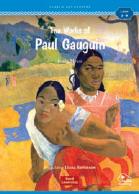


• Allows learners to develop their reading uency through extensive reading practice
• Presents strictly controlled vocabulary over the graded levels of the series
• Includes comprehension questions in each reader to encourage learner accountability
• Highlights level-appropriate terms in succinct glossary pages
• Provides audio tracks for enhanced ow, concentration, and comprehension
• Introduces important museums around the world
Levels 1 2 3 4 Base Vocabulary 750 1000 1250 1500 Word Count 600 800 700 900 ERF Scale Elementary Lower-Intermediate Intermediate CEFR A2 B1 B1 B1
Lesson Plans Teacher’s Slides Downloadable Resources: MP3 Files Activity Pack Biography Flapbook New 28
Levels and Content



























































Why is learning about classic art important?






















“Art enables us to nd ourselves and lose ourselves at the same time.” – Thomas Merton



























“Painting is a means of self-enlightenment.” – John Olsen




































































“An artist cannot fail; it is a success to be one.” – Charles Horton Cooley














“Everything has its beauty, but not everyone sees it.” – Andy Warhol


Level 1 - 1 The Works of Leonardo
Leonardo da Vinci was a famous Italian painter. However, he was more than just painter. Introduction great painter!
da Vinci
5 The Works of Jean-François Millet
4 The Works of Johannes Vermeer
3 The Works of Rembrandt
LEVEL 1
2 The Works of Michelangelo
Level 2 - 1 The Works of
Degas Edgar Degas was famous Impressionist painter. He was born in Paris, France, though his mother was from New Orleans, USA. He had big family, with four younger brothers. Introduction A self-portrait of Degas (c. 1855)
1 The Works of Leonardo da Vinci
Edgar
5 The Works of Pierre-Auguste Renoir
4 The Works of Claude Monet
3 The Works of Auguste Rodin
LEVEL 2
2 The Works of Paul Cézanne
Level 3 - 1 The Works of Paul Gauguin Paul Gauguin was an important French painter, printmaker, and sculptor. He began as a painter with the Impressionists in Paris. Over time, he turned away from this style of painting to create his Introduction Self-portrait at Lezaven by Gauguin (1888)
1 The Works of Edgar Degas
5 The Works of Wassily Kandinsky
4 The Works of Edvard Munch
3 The Works of Gustav Klimt
LEVEL 3
2 The Works of Vincent van Gogh
Level 4 - 1 The Works of Henri Matisse Henri Matisse was born in a small town in the north of France. Like many early artists, Matisse had many di erent talents. He could paint, draw, sculpt, and illustrate books. Introduction
1 The Works of Paul Gauguin
5 The Works of Frida Kahlo
4 The Works of Marc Chagall
3 The Works of Pablo Picasso
LEVEL 4
2 The Works of Piet Mondrian
1 The Works of Henri Matisse
READERS
29
WORLD HISTORY READERS
Level: High-Beginning to Intermediate

Series Editor: Rob Waring


Seed Learning’s World History Readers is a non ction series from world history. There are stories about Cleopatra, Alexander the Great, Leonardo da Vinci, Genghis Khan, the French Revolution, the Birth of the USA, and much more. These are exciting stories about historical people and events which shaped our world then, and still do today.



Features



• Informative and engaging accounts of historical gures and events





• Extensive reading practice that allows learners to develop their reading uency
• Strictly controlled vocabulary presented over the graded levels of the series
• Comprehension questions included in each reader to encourage learner accountability
• Subject-speci c terms related to the reader’s topic explained















READERS MP3 Files Answer Keys (WB) PPT Downloadable Resources: Workbooks Video Supplements Available on YouTube www.seed-learning.com/WHR 30
Interesting and Exciting Readers about World History!
Seed Learning’s World History Readers develops critical skills while giving students an opportunity to experience and re ect on key historical events, people, and places. With this series, students learn and understand how past world events a ect people today.











































































































































































The World History Readers series was designed to serve a dual purpose. One purpose of the series was to provide interesting and instructive materials for extensive reading practice. A second, and equally important, purpose of the series was to create a library of general knowledge accessible to young learners. As readers explore this library, they will expand their real-world knowledge of historical events that are important for students worldwide to learn.


READERS
Rob Waring Ph. D.
Levels 1 2 3 4 5 6 Base Vocabulary 800 1000 1250 1500 2000 2500 Word Count 600 750 900 1050 1200 1400 ERF Scale Elementary Intermediate Upper-Intermediate CEFR A2 B1 B2
Casey Malarcher Ph. D.
31
READERS










































Levels and Content





































































































Level 2 - 4 The Agricultural Revolution New foods were introduced such as rice and the high-energy potato which allowed us to get the nutrition we needed. Plus, people didn’t have to work so hard to grow the crops. People could also sell much of what they grew in towns and markets. This meant people had more free time to work on other things, or they could move to towns and cities to look for work. This A potato crop As societies grew, people ate better and got healthier. People lived longer. We could now grow many wider variety of things. The problem was that this was also hard work, and we could only grow food for ourselves. Baskets of spices
1 The Ottomans and Their Empire
2 The War Between the States
3 The Industrial Revolution
4 The Agricultural Revolution
5 Wars in the Middle East
6 The British Empire, Then and Now
7 The Neo-Assyrian Empire
8 The Rise and Fall of Communism
9 The History of Printing
Level 3 - 4 The French Revolution The Guillotine The new parliament thought the king and queen might try to stop them changing France. So they did something very extreme. They built a new machine called the guillotine. The guillotine was designed to kill people quickly and One of the first people to face the guillotine was the king. A huge crowd gathered to see it. The king forgave the people as he stood next to the guillotine. cut o his head! Many hundreds of people The Women’s March to Versailles The women of Paris were unhappy because their families were hungry. Many of them, along with some men, marched to Versailles. They shouted against the monarchy, walking through the rain and shouting, “Bread! Bread!” They carried sticks and guns. They marched for nearly 20 km. The people were very angry with the queen. There was people didn’t have bread, Marie Antoinette said, “Let them eat cake!” She did not understand that the people were hungry. Tuileries, August 1792
of the Americas 3 Cleopatra 4 The French Revolution 5 Benjamin Franklin 6 Galileo Galilei 7 The Battle of Salamis 8 Tea and Wars 9 Christopher Columbus 10 The Trojan War LEVEL 3 Level 1 - 3 The Tower of Babel The tower got bigger and bigger, taller and taller, and the people were happy. They were working together as one people. painting by Tissot the building of the tower mud bricks Some of Noah’s children’s children went east to a land called Shinar, sometimes said to be Babylon, in modern-day Iraq. Some years later, these people decided to build a tower “tall enough to reach heaven.” They wanted to be one people, close to God. The historic city of Babylon 1 Calendars and the History of Time 2 Searching for El Dorado 3 The Tower of Babel 4 The Pilgrim Fathers 5 Traveling on the Silk Road 6 The Invention of Writing 7 The Making of a United Europe 8 The Magic of Numbers 9 The Persian Empire 10 The Great Wall of China LEVEL 1
10 The Vikings and Erik the Red
LEVEL 2
1
Space Exploration
2
The Spanish Conquest
32





































































































































READERS Level 6 - 10 China’s First Empire: The Qin Dynasty The Mystery of the First Emperor’s Tomb What about the rest of Qin Shi Huang’s fabulous tomb? When Xiang Yu “ruined” it, did he take all the gold, silver, and jewels out? Thanks to the lucky find of the farmers, we know where Qin Shi Huang’s tomb is. We can easily see the outside of it. However, scientists have not opened the tomb because they do not want to damage anything inside. For this reason, the question remains. What is inside? Scientists have found mercury in the earth around the tomb. Maybe the rivers of mercury are there. Maybe scientists will open the tomb and find a ceiling of stars and planets made of gold and jewels! The tomb of Qin Shi Huang, T not an emperor because he could not Ziying, and he ruled for only 46 days. The rebellion continued, and rebel general, Xiang Yu, destroyed Xianyang and killed Ziying and his family. When Xiang Yu destroyed Xianyang, he burned the imperial libraries. These libraries had the last two copies of all the books that the first emperor had burned. Historians also wrote that this general ruined the fabulous tomb of the first emperor. The End of the Qin Dynasty The destruction of Xianyang and the burning of the imperial libraries 1 World War I 2 Communication Technology 3 The First Democracies 4 The Cold War 5 Global Trade and Peace 6 Greek Culture 7 Napoleon 8 The History of Transportation 9 Capitalism: Good or Evil? 10 China’s First Empire: The Qin Dynasty LEVEL 6 Level 5 - 8 Decisive Battles of World War II The Battle of Midway Six months er Pearl Harbor, the Japanese still hoped to destroy the US aircra carriers. In June 1942, the Battle of Midway began. The Japanese planned to invade Midway, capture it, and use it as their own military base. Midway Atoll is part of the Hawaiian Islands. The Japanese knew these islands were important because they were in the center of the Pacific Ocean. Japan wanted to tempt the American fleet into a trap. They spread their fleet out into groups so that the Americans would not find out how many there were. Japanese ship after having been bombed the Battle Midway. The Paci Ocean, showing Midway The Japanese went to war with China in 1937. They wanted greater control of imports, exports, and important resources such as coal and oil. However, the United States disapproved of Japan’s war with China. The Japanese were worried that the United States would attack them. Japan knew that having a powerful navy was essential to winning the war because the Pacific region is dominated by ocean. So they attacked the US ships at Pearl Harbor. The Japanese believed that this would protect them from the US Navy for some time. Attack on Pearl Harbor China during generated image of Japanese aircraft 1 The Story of the Renaissance 2 The Great Plague 3 The Mughal Empire 4 Popes and Kings in the Middle Ages 5 Tutankhamun 6 The Story of the Reformation 7 The Medical Revolution 8 Decisive Battles of World War II 9 China: The New Superpower 10 The Great Depression LEVEL 5 Level 4 - 2 Leonardo da Vinci The Notebooks Leonardo liked to keep all of his ideas in his notebooks. He had strange way of writing his notes. Instead of writing normally, he wrote every word backwards, perhaps so no one could read his notes. have survived. But actually, much of what the ideas he must have had! Leonardo’s Apprenticeship A the age of fourteen, Leonardo moved to Florence. He began an apprenticeship with one of the most There Leonardo learned to paint pictures, make sculptures, and even design buildings. One story is that while Leonardo and his teacher were working on painting together, The Baptism of Chris Verrocchio his own. They say that Verrocchio put never painted probably an
1 Alexander the Great 2 Leonardo da Vinci
3 The NeoBabylonian Empire
4 The Birth of the United States of America
5 Life and Death in Ancient Egypt 6 Life in the Roman Army 7 The Great Plane Race
8
Genghis Khan 9 Korea: A Land Divided by War
LEVEL 4 33
10 The Crusades
www.seed-learning.com/WT
WRITING TIME
Level: Beginning
Writing Time is a three-book series designed to develop the writing skills of elementary students of English (CEFR A1). The series uses a model writing approach to build the writing skills of English language learners in a clear and accessible way. Each unit features three complete model passages presented through various activities. Students use the structures provided in these models along with their own ideas to create personal passages. Students who complete this series will develop stronger writing skills and gain con dence in their ability to write in English.


Features
• Wide range of writing topics including family, friends, school subjects, hobbies, interests, and special occasions
• Practical exercises and activities modeling how students can organize and prepare their own passages
• Multiple sample passages providing ideas for students to incorporate in their own writing

• Personal re ection questions within each unit to assist students with brainstorming
• Fundamental language patterns and sentence structures practiced through simple writing activities
• Repeated recycling of useful kid-friendly vocabulary
• Pull-out full-color workbook included
Downloadable Resources:
WRITING New
Teacher’s Slides Lesson Plans Word Lists Tests Teacher’s Guides 34
Student Book
New Words
Introduces key words related to the unit’s topic along with pictures to provide context for vocabulary items.
Sentence Practice
Provides additional vocabulary and grammar practice through writing and speaking and serves as a springboard for students to brainstorm about their own writing.
Writing Practice
Introduces ideas for alternative model passages through activities that mirror guided question from the first model passage.
Presents students with vocabulary and guided questions to construct sentences for their own writing.
Writing Skill
Gives a pattern-practice activity for review of a useful target grammar structure.


Writing Tip
Reinforces student understanding of the grammar point.
Model Writing
Presents a model passage with guided questions to help students focus on ideas to write about.
Writing Practice (cont.)
Concludes with an activity that guides students through reconstructing a passage from the content of the previous page.
Fix It
Practices editing skills to recognize errors in spelling, capitalization, punctuation, word choice, and grammar.
Your








(cont.)
Provides a page for students to write












Write two words under the correct picture. spring warm fall cold cool winter hot summer 1. 3. 2. 4. What season is it? It is About You New Words My Favorite Season Unit 01 8 Write the correct sentence in the blank. The snow falls. The leaves are green. The snow melts. The leaves are red. 1. It is spring. 2. It is summer. 3. It is fall. 4. It is winter. Writing Tip The snow melts ✓ The leaves green. ✓ ) green. 01 Writing Skill 9
WRITING
A Complete the sentences. play in the leaves goes swimming make a snowman fly a kite B Write and tell a friend what you do. go skiing eat ice cream have a picnic 1. I 3. 2. He 4. Sentence Practice 10 1. What season is it? 2. How is the weather? 3. What happens? 4. What does Gary do? 5. What else can you do? Read Gary’s writing and answer the questions. It is It’s The snow He Let’s Gary It is winter. Brrr! It’s cold. The snow falls. We mak We go skiing. It’s cold, but like winter. Model Writing 01 11
B Look at picture B and write the answer. play in the sand go swimming sun shines hot 1. What season is it? 2. How is the weather? 3. What happens? 4. What do you play in? 5. What else do you do? A B A Look at picture A and match with the answer. 1. What season is it? a. play in the leaves 2. How is the weather? b. fall 3. What happens? c. cool 4. What do you play in? d. leaves are red 5. What else do you do? e. have a picnic Writing Practice C Use the answers from A or B to complete the sentences. 1. It is 2. Wow/Ahh/Brr! It’s 3. The 4. play 5. 6. It’s and like There are some mistakes. Rewrite the sentences correctly. 1. it is spring. 2. Me fly a kite. 3. The snow melt Fix It It is spring. 01 13
A Think about your favorite season. Circle what you want to use in your own writing. B Answer the questions using what you have circled. 1. What season is it? 2. How is the weather? 3. What happens? 4. What do you play in? 5. What else do you do? spring winter summer fall warm hot cool cold snow melts leaves are green snow falls leaves are red fly a kite play in the leaves play in the park eat ice cream go swimming have a picnic play in the snow play in the sand My F vo te Season Your Writing 01 It is Wow/Ahh/Brr! It’s The play It’s and like C Write using your answers from My Favorite Season 3
Writing
the final
their
draft of
own passage. Your Writing
Workbook 35
www.seed-learning.com/EW
EARLY WRITERS
Level: Beginning
Early Writers is a three-book series designed to develop the writing skills of elementary students of English (CEFR A1). The series uses a step-by-step approach to build the writing skills of English language learners in an interesting and fun way. Each unit features an original passage with useful vocabulary and helpful sentence patterns. Students use the model as a guide to create their own personal passages. Students who complete this series will develop stronger writing skills and gain con dence in their ability to communicate.
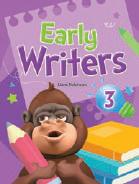


Features
• Wide range of enjoyable writing topics including school subjects, hobbies, emails, and special occasions
• Practical exercises and activities allowing students to organize and prepare their own passages
• Multiple sample passages providing ideas for students to incorporate in their own writing
• Large variety of graphic organizers to assist students with planning and organization
• Fundamental writing patterns and sentence structures highlighted in each unit to build students’ language skills
• Repeated recycling of useful kid-friendly vocabulary
• Pull-out full-color workbook included
WRITING Downloadable Resources: Teacher’s Slides Lesson Plans Word Lists Tests Titles A1 A1 High A2 Low Early Writers1 2 3 Good Writers 1 2 3 Smart Writers 1 2 3 CEFR Level The Writers Series Levels Coming soon! Teacher’s Guides New 36
Student Book
Warm Up
Introduces students to the unit topic and exposes them to important sentence structures.
Writing Focus






Gives a simple grammar point for students to review and practice. Most units also include a tip to help students understand usage of the grammar point.




Model Writing
Has a model passage that provides students with a framework for their own passages.

Writing Tip
Each passage also includes a helpful reminder in the form of a writing tip.



















Writing Practice
Provides students alternative samples of two further writing passages highlighting the unit’s vocabulary and sentence patterns.

























Workbook



Check It
Gives students a chance to practice their editing skills. Students should also use the editing list to review their own first draft.



Word Practice




Provides useful vocabulary and sentence structures that students will use in their own writing.
Writing Ideas

























Helps students begin to generate their own ideas while learning additional vocabulary.

Model Writing (cont.)
The second page helps students study how the model passage is structured using guided questions and a graphic organizer.
Guided Writing

Helps students organize their ideas using a graphic organizer and provides space for students to complete guided first draft.

WRITING
A Look and read. B Read and write. 2. His name is He is old. 1. My name is am old. Liam ten Liam/ten Max/four About Me Unit 01 Warm Up A Look and write. 2. 11 3. 13 4. 12 5. 9 6. 8 1. 10 ten eight ten thirteen nine eleven twelve B Look, read, and write. years old. 2. have dogs. 3. She is years old. 1. eleven 13 12 Word Practice 01
ten years old. ten years old. ✗ A Read and circle. 1. They (am / is / are) my friends. 2. He (am / is are) eleven years old. 3. (am is / are) a boy. B Look, match, and write. 1. I am ten years old. 2. 3. My brothers (They) My dog (He) is • • • nine years old. ten years old. six years old. Tip She/He/It is You/We/They Writing Focus 10 Unit A Look, read, and say. B Look and write. have His name is 1. Joe have Her is Ellie. 2. have His name 3. Loki a teddy bear a monkey an elephant have a monkey Writing Ideas Unit 01 11
A Read. This is about me. My name is Ben. am eleven years old. have a goldfish. Her name is Elsa. She is two years old. love Elsa. goldfish Words Writing Tip Names start with capital letters. Find and circle two names in the passage above. B. Check ✓ the correct sentence. 1. Her name is anne. My name is James. About Me ✓ Model Writing 12 B Read the passage again. Match and write. 1. What is your name? a. am years old. 2. How old are you? b. Her name is 3. What pet do you have? c. She is years old. 4. What is her name? d. My name is 5. How old is she? e. have a C Write. Use the answers from above. Age Name Name Pet/Toy Age Me Ben 01 13
A Look, read, and circle. This is about me. My name is / Noah. thirteen years old. have a rabbit / an elephant). Her name is Rose. She is are eight year / years old. love Rose. B Look, read, and write. This is about My is Rina. am years old. have a His name is He three years old. love Ted. seven me Ted teddy bear is name Ted/3 me Writing Practice 14 A Write. Use your own ideas. Age Name Name Pet/Toy Age Me B Write your first draft. Then check your writing. This is My name is years old. have His/Her name is He/She old. love Guided Writing 01 15
Check It ✓ A Find the mistakes in the passage and write -6). B Read and fix the mistakes. Examples Punctuation am ten years old am ten years old Capital letters lucy Lucy Spelling have monki have a monkey Wrong words His name Paul. His name is Paul. This is about me. My name is sarah telve years old. have a dog three years old love Mimi. About Me ✓ 5 About Me Unit 01 Writing on My Own Write your final draft. 3
on
Own
Writing
My
final
Students write their
draft.
37
www.seed-learning.com/GW
GOOD WRITERS
Level: High-Beginning
Good Writers is a three-book series designed to develop the writing skills of English language learners at the high beginning level of English (CEFR A1 High). Each unit features two model writing passages with useful vocabulary and helpful sentence patterns which students can use to create their own passages. Throughout the series, students learn how to organize their thoughts, put sentences together, and choose suitable topic and concluding sentences. The series also encourages students to edit their writing—an important part of the writing process. Students who complete this series will develop stronger writing skills and gain con dence in their ability to communicate through the written word.



Features
• Wide variety of engaging writing topics including school, daily life, hobbies and interests, hopes for the future, giving advice, books, and music
• Practical exercises and activities allowing students to organize and prepare their own passages
• Multiple sample passages providing ideas for students to incorporate in their own writing in a variety of writing styles including emails, letters, reports, posters, journals, reviews, and essays
• Graphic organizers to assist students with planning and organization
• Fundamental writing patterns and sentence structures highlighted in each unit to build students’ language skills
• Writing tips to enhance students’ writing skills
• Pull-out full-color workbook included
Downloadable Resources:
WRITING
Teacher’s Slides Lesson Plans Word Lists Tests Teacher’s Guides New 38
Student Book
Warm Up

Introduces students to the unit’s topic and provides exposure to vocabulary and expressions that they will see and use throughout the unit.
Writing Practice
Gives a simple grammar point to review and practice. Units also include a tip to help students understand the usage of the grammar point.
Model Writing 2
Presents key information from a model writing in a graphic organizer. Students use this information to complete a passage in preparation for writing their own passage later.
Guided Thinking (cont.)
Presents a variety of graphic organizers to facilitate brainstorming and the organization of ideas.















Workbook

Writing Skills





The first page of the workbook provides additional practice of the target language from the unit with error correction and writing activities.

Writing Model 1



Re-introduces some of the vocabulary from Warm Up in context and provides students with a sample passage.
Writing Ideas
Provides additional vocabulary to use in the unit’s target structures. This page also encourages students to start generating ideas.
Guided Thinking
Begins with a helpful writing tip, then transitions to having students think of the important information they may want to include in their own passage.
Guided Writing

Provides sca olding to guide students in writing their own passage. An editing checklist helps students identify and correct errors.




Final Writing
After checking their first draft for errors, students use the second page of the workbook to write their final draft.
WRITING Warm Up Unit Objective: Write about your daily routine Unit 01 My Day A Look and read. What do you do before school? What do you do after school? pack my bag before school. go to coding club after school. B Look at the pictures and write the words under the correct pictures. 5. 6. 7. 8. play sports write in my journal watch videos do my homework 1. 2. 3. 4. brush my hair hear my alarm wash my face brush my hair eat breakfast Writing Model 1 01 A Read. B Imagine you are the writer. Answer the questions. 1. When do you hear your alarm? hear my alarm at 2. What do you do before breakfast? Before breakfast, 3. What do you do after school? After school, 4. What do you usually do at seven thirty? at seven thirty. 5. What do you do before bed? before bed. six thirty Let me tell you about my day. hear my alarm at six thirty. Before breakfast, wash my face. eat brea fast at seven o’cloc brush my teeth after breakfast. study at school from eight o’cloc to three o’clock After school, play sports. do my homewor in the afternoon. eat dinner at seven thirty. After dinner, watch videos. write in my journal before bed. My day is full. My Day
Writing Practice in in the morning in the afternoon / in the evening before before breakfast before school before bed eight thirty night A Look and read. the morning Before breakfast wash my face. Tip B Look and write the sentences using the given words. after breakfast at seven thirty after dinner 1. (brush my teeth) 2. (watch videos) 3. (wash dishes with my mom) After breakfast, brush my teeth. C Read. Fill in the missing words. This is what do school. go to coding club the afternoon. dinner, ride my scooter. After dinner, do my homework and watch videos. also write in my journal to relax. take bath nine thirty. Then go to bed at eleven o’clock Writing Ideas 01 go to soccer club brush my teeth take a bath eat snack watch TV ride my bike Morning Evening B Write the ideas under the correct topic. Ideas can be used more than once. hear my alarm at seven o’clock. Before breakfast, and Then eat breakfast at eight o’clock. After breakfast, ride my bike to school. study at school from nine o’clock to three o’clock. In the afternoon, Before dinner, eat dinner at six o’clock. After dinner, and C Fill in the blanks using the ideas from above. A Read. Add your own ideas for things you do every day. set table wash the dishes
Writing Model 2 My Day want to tell you about my day. hear my alarm Before breakfast, brush my hair. eat breakfast at seven thirty. brush my teeth study at school from eight o’clock to three o’clock After school, in the afternoon. eat dinner at eight o’clock. After dinner, and pack my backpack. What a busy day! at seven o’clock A Look at the organizer. B Look at the organizer above. Fill in the blanks. Morning Hear my alarm seven o’clock brush my hair 7:30 brush my teeth Afternoon Study at school eight o’clock to three o’clock Evening Dinner eight o’clock wash the dishes pack my backpack 12 Guided Thinking 01 A Read the questions and sample answers. Then write your own answers. Use a comma (,) when the time phrase is at the beginning of the sentence. wash my face before breakfast (no comma) wash my face. (needs a comma) Tip 1. What do you do before breakfast? wash my hair before breakfast. 2. What time do you eat breakfast? 3. When do you study at school? study at school from nine o’clock to three o’clock. 4. What do you do after school? 5. What do you do in the afternoon? do my homework in the afternoon. 6. What do you do before bed? 13
B Complete the organizer. Morning Hear my alarm breakfast Afternoon Study at school Evening Dinner Title: ____________ 14 Unit Guided Writing 01 B Check your writing using the checklist below. A Write your rst draft. It’s OK to make mistakes here! Is there punctuation at the end of every sentence? Is the spelling correct? Did you use in, before, after, or at correctly? Did you use commas with time phrases correctly? Student Checklist Choose Choose one: want to tell you about my day. Let me tell you about my day. hear my alarm Before breakfast, eat breakfast study at school from after school. In the afternoon, eat dinner My day is busy. / What a busy day! 15
Writing Skills Unit 01 My Day 2. after school watch videos. 3. packs my bag before school. After dinner do my homework. I eat breakfast at six o'clock. brush my teeth after breakfast. A B Write your own sentences using the words given. 1. (after breakfast) 2. (in the afternoon) 3. (after school) 4. (at seven o'clock) Final Writing Write your nal draft. 3
39
www.seed-learning.com/EL
EARLY LISTENERS
Level: Beginning


Early Listeners is a three-book series designed to develop the listening skills of students as they move from the beginning to high-beginning levels of English (CEFR A1). Each unit in Early Listeners features distinct listening opportunities including short and long conversations, talks, and videos. This listening series not only utilizes traditional activities where students learn to listen for main ideas and speci c details, it also utilizes innovative activities designed to appeal to learners today through technology and audio-visual media. An accompanying workbook provides additional listening exercises.



Features


Thematically-Organized Topics




















































• Help students build connections between language and content and learn English naturally






Illustrated Vocabulary
• Provides visual examples to support audio input for vocabulary practice and development


Conversations and Talks
• Showcase unit topics through everyday situations to help learners increase their knowledge of spoken English
Videos


• Provide additional context and make each lesson more meaningful
Student Book
Warm Up
Provides three activities introducing some of the vocabulary and sentence structures that students will hear throughout the unit.

Practice
Provides practice in both listening for ideas and listening for details. The activities are building blocks for what will be heard in the rest of the unit.

Warm Up 1 Unit Hello! B Listen and say. morning 1. afternoon 2. evening 3. night 4. grade grade 5. name 6. 3rd third 7. 4th fourth 8. C Listen to again. Check ) the words you hear. A Listen, read, and say. Hi! My name is Sarah. Hello. We are, too! Good afternoon. I’m om. My name is Zoe. I’m in third grade. 8 Unit 1 Practice A Listen and choose. 1. b c James a Mike b Kevin c B Listen and write the letter (a-d). Hello. I’m in fourth grade. My name is Don. I’m Joe Chatters. 3 2 4 9
LISTENING
MP3 Files Downloadable Resources: Word Lists
PPT Lesson Plans Tests 40
Listening 1 & 2

Listening 1 is a conversation between two speakers. It is followed by two di erent types of listening for details exercises.
Listening 2 is a monolog. It is followed by a listening for detail comprehension exercise.
















































Both Listening 1 and Listening 2 build on the language introduced in the previous activities.


Listening 3

Features a video conversation between two speakers which allows learners to observe the interaction of the speakers while listening to the conversation. It uses a slightly di erent approach to review language from the unit. It is followed by two di erent listening for detail exercises. The last exercise on the page allows students to role-play both sides of the conversation using a follow-up video.
Workbook














Word Focus



Highlights key words and/or phrases that will be heard in the listening passages. Students get a chance to hear these words individually and within sample sentences before they hear them used in the main conversation/monolog.




Close Up


Both pages end with Close Up grammar segments that clarify important points or highlight useful information.









Skills Focus & Speaking







Summarizes and reviews what has been learned in the unit. The Skills Focus activity focuses on key sentence structures and serves as a mini-review while the Speaking section expands on the review and brings everything together.




Provides four pages of additional practice per unit, and it can be completed as homework or in class. The first two pages of workbook activities review vocabulary and sentence structure.








The last two pages of the workbook review Listening 1-3 and practice listening for details. Finally, at the bottom of the last page, students are asked to write about themselves. This activity helps students consolidate and personalize what they have learned.

Listening 1 Focus Word Ben Lewis first name Ben Lewis last name Canada dog spell Listen and say. What is What’s am ’m It is It’s What’s your name? ’m John. It’s Jones. Close Up B Listen again and complete the sentences. 1. your name? 2. How do you that? 3. you a new student? A Listen and write. First Name E v e B y t 1. First Name g V s 2. 10 Listening 2 Focus Word pet like jog selfie Listen and say. 1st 2nd 3rd 4th 5th 6th first second third fourth fifth sixth Close Up Listen and choose. 1. What goes here? b. The boy’s first name is Sam b. Seth Simon 3. He is in grade. 6th b. 4th 5th 11 Listening 3 B Circle T for true or F for false. 1. Nina is new. T F 2. They like soccer. T F 3. Now they will jog. T F C Watch and say the roles. 1. You are Nina. 2. You are Jarod. A Watch and write. What are their names? 12 Speaking A Listen and say. G: What’s your name? B: My name is Riley Mills G: How do you spell that? B: My first name is R-I-L-E-Y And my last name is M-I-L-L-S G: What grade are you in? B: I’m in third grade. B Say with a partner. Change the words above. 1. Karen Park 2 2. Reggie Walker 5 3. Monica Ivy 4 Focus Skills Listen, match, and write. What do they like? How do they spell their names? 1. a Ja ki 2. b ak ta 13
LISTENING
Practice Hello! 1 Unit A Match and say. 1. night 2. evening 3. jog 4. Canada b. d. B Follow and write. I’m in grade. h h d s f h d t 1. 2. 3. 4. 5. 2 D Choose, write, and say. Some words will NOT be used. grade last like first spell My name is Max. like the park. 1. Max Miller My name is Sands. like selfies. 2. Vera Sands my name Y-O-O-N. like 3. Yoon Zhao C Circle and say. 1. A: Hi. My name is / are Katie. B: Hello. I’m Trevor. A: Are / What grade are you in? B: I’m in four / fourth grade. 2. A: Hi. How’s / What’s your name? B: I’m Joe Chatters. A: How / What do you spell your first / last name? B: It’s C-H-A-T-T-E-R-S. 3 Dictation Hint afternoon pet I’m jog student last grade spell What’s A Listen and write. Girl: Hi. Eve Bryant. E-V-E. Eve. B-R-Y-A-N-T. Bryant. your name? Boy: My name is Nigel Voss. Girl: How do you that? Boy: My first name is N-I-G-E-L. My name is V-O-S-S. Girl: Are you a new ? Boy: Yes. I’m from Canada. B Listen, write, and say. Good I’m Seth. It’s S-E-T-H. My last is Pacer. P-A-C-E-R. I’m in fourth have a dog. His name is Hank. It’s H-A-N-K. We like the park. We and play. We also like selfies. 4 Hello! My first name is My last name is I’m in grade. like About You Write and say. Use your own information. C Listen and write. Boy: afternoon. I’m Jarod. That’s J-A-R-O-D. Girl: Hi, Jarod. I’m Nina. Are you ? Boy: Yes, am. What’s your name again? Rita? Girl: No, N-I-N-A. Nina. Boy: Ah, Nina. Do you soccer? Girl: Yes, do. Come on. Let’s 5
41
Sample Video
GOOD LISTENERS
Level: High-Beginning
Good Listeners is a three-book series designed to develop the listening skills of English language learners at the high beginning level (CEFR A1-High). Each unit focuses on thematically categorized dialogs and short talks that are based around topics relevant to the typical learner’s life. Each unit contains a variety of listening tasks ranging from checking general comprehension to testing discrete listening items with multiple choice questions and graphic organizers to complete. An accompanying workbook provides additional listening comprehension practice along with dictations.



Features



Thematically Organized Topics














• Help learners focus on subject-speci c content and language
Step-by-step Learning Process
• Guides learners to develop their listening skill from focusing on individual sentences to comprehending dialogs and short talks
Appendix: Vocabulary List

• Provides additional lexical information for further vocabulary practice and development

LISTENING MP3 Files Downloadable Resources: Word Lists
Titles A1 A1-High A2-Low Early Listeners1 2 3 Good Listeners 1 2 3 Smart Listeners 1 2 3 CEFR Level PPT Lesson Plans Tests The Listeners Series Levels 42
www.seed-learning.com/GL
Student Book
Topic Talks & Word Focus





The first page of each unit starts with a warm-up activity to get students thinking about the topic of the unit. This page also introduces useful vocabulary which the students will hear in the various activities throughout the unit.



Listening Focus 1










Students listen to a dialog between two speakers. First, they check for main ideas in a True/False activity. Then they listen for details.
Each dialog in Listening Focus 1 contains a Useful Expression to enhance students’ knowledge of idiomatic English.






















Wrap-up Test









Each unit ends with a twopage test to consolidate what the students have learned in each unit.
Workbook





Short Listening











Students listen for target words from the unit in a new context. Students match dialogs to the correct image, then check the target words that they hear in the dialog.
Listening Focus 2



Students listen to a short talk focused on the theme of the unit. Students practice their listening comprehension skills as they answer multiple choice questions, then complete an organizer related to the content of the talk.
Appendix: Vocabulary List













An appendix presents the target words from the unit and additional useful words for further vocabulary practice and development. For each word, students see an interesting photo, a definition, and a sample sentence related to the photograph. These pages also provide parts of speech and pronunciation guides. This additional lexical information is useful for memory retention and fluency development.
A workbook with four pages per unit accompanies each level of the series. Word Review and Dictation activities provide the opportunity to review the material from each unit. Each activity can be completed in class or as homework.



LISTENING Word Review What’s in your house? Unit 1 A Write the correct word next to each picture. 1. 2. 3. 4. 7. 8. B Read and match. 1. Is your coat in the wardrobe? There are two. 2. Is there a nightstand by your bed? b. Yes. sit on it to watch TV. 3. Do you have couch? No, didn’t put it away. How many armchairs are there No, but there is a table. in the living room? 2 C Fill in the blank with the correct word(s) from the box. couch shelf wardrobe chest of drawers armchair 1. You keep your coats and jackets in a(n) 2. Only one person can sit on a(n) 3. More than two people can sit on a(n) 4. You can put books on a(n) 5. People keep small clothes like socks and T-shirts in a(n) D Look at the picture and read the sentence. Check true (T) or false (F). 1. Dictation Short Listening Listen and ll in the blanks. 1. Boy: Is there a in your Girl: Actually, there are six 2. Boy: Please down. Girl: Thanks. I’ll sit on the 3. Boy: do you keep your ? Girl: them in a 4. Girl: What color are the in your Boy: Our cabinets are light Listening Focus Listen and ll in the blanks. Boy: This is a beautiful What do you in the two chairs, two and some We at the table. Boy: do you have in your ? Girl: There’s a also a desk and a Boy: Do you have a ? Girl: Yeah. And there is a on my it when read in Boy: you use the when you study? 4 No, to study in Boy: OK, and what do you have in the I’ll show you. There is a two armchairs, a table, and Take a We can keep talking in Listening Focus 2 Listen and underline the sentence or phrase that gives the main idea. Listening Skill Today have to clean up the house before Mom and Dad get home. I’ll start in the kitchen. They asked me to wash the dishes and then put them away. We keep our dishes on a shelf. But I’m not tall enough to reach. can’t put the dishes on the shelf. So, will just wash them. After that, have to clean my room. Mom is angry because there are a lot of clothes on my bed. She said, “There is a very nice wardrobe in your room! Why don’t you use it?” So now have to put all my clothes in the wardrobe. Then have to do my homework. But there are lots of clothes on my desk, too. guess I’d better get started. 5 What is your favorite room in your home? Why do you like that room? Topic Talk Word Focus What’s in your house? Unit 1 B Listen and write the correct number by each picture. A Listen and repeat. wardrobe cabinet furniture shelf nightstand couch chest of drawers stool 8 Short Listening A Listen and circle the number under the correct picture. 1 2 3 4 D 1 2 3 4 C 1 2 3 4 A 1 2 3 4 B B Listen again. Check the words you hear. shelf stool couch armchair wardrobe drawer nightstand cabinets
Listening Focus 1 A Listen and check true (T) or false (F). 1. The boy is visiting the girl’s house. T F The girl does not talk about the kitchen. 3. The boy likes the house. T F B Listen again. Choose the best answer. 1. Which room do the speakers talk about rst? a. Living room b. Kitchen c. Bedroom 2. When she studies, the girl sits on the b. 3. Which kind of furniture is NOT in the girl’s living room? a. Co ee table b. Armchairs c. Shelf Listen to the expression. Take a seat. A: Take a seat. You must be tired. B: Thanks. I’ll sit on the couch. Expression Useful 10 Listening Focus 2 A Listen and choose the best answer. 1. What does the girl have to do? Wash clothes b. Call a friend Clean the house Where should the girl put the dishes? In a cabinet b. On a shelf On the table 3. What is likely to be true about the girl? a. The girl doesn’t put her clothes away. The girl is good at washing dishes. The girl often makes her dad angry. B Listen again. Put the pictures in the correct order. b c
Wrap-up Test B Listen and choose the best answer. At rst, what does the boy want to buy for the living room? Three armchairs b. A chest of drawers c. Two couches What color furniture does the boy want to buy? Silver b. Black Red 6. Which of the following is NOT true? a. The boy and his mom both agree to buy a couch. b. The boy’s mom says they can buy more than one armchair. Today, the boy and his mom will buy furniture online. A Listen and write the letter that matches the picture. 1 2 3 12 Unit 1 C Listen and choose the best answer. 7. What did the girl’s dad nd on the couch? b. 8. Where does the girl say her coat is? b. 9. What does the girl’s dad say he will make? Co ee 10. Why does the girl’s dad say, “Hey!”? a. He is happy. 11. Why are there no cups in the cabinet? The girl forgot to wash them. b. The girl broke them. c. The girl put them in the wardrobe. What is likely to be true about the girl? She is tidy. b. She likes co ee. She doesn’t like to clean. armchair a chair with parts for you to rest your arms on An armchair is very comfortable. nightstand [ˈnɪtˌstænd] a small table you put next to bed keep a clock and a lamp on my nightstand cabinet [ˈkæbənɪt] a place with small doors where you keep things There are many cabinets in my kitchen. plant [plænt] a living thing, often kept in a pot plant will need water every day. chest of drawers ɛst ʌv drɔrz] a piece of furniture with drawers for keeping clothes in keep my clothes in a chest of drawers shelf ɛl n. a at piece of wood, metal, or glass to keep things on There are three plants on the shelf couch [kaʊt n. a long seat for two or three people relax on the couch when read. stool [st n. a seat with three or four legs and no back or arms have one stool in my kitchen. furniture rnɪt ər] things such as chairs, tables, desks, etc. The furniture in this room is black and brown. Vocabulary List wardrobe a tall piece of furniture for hanging clothes in keep my wardrobe tidy inside. 1 Appendix
43
www.seed-learning.com/SL

SMART LISTENERS
Level: Pre-Intermediate Level
Smart Listeners is a three-book series designed to consolidate the foundational listening skills of English language learners at the pre-intermediate level (CEFR A2-Low). Each unit focuses on thematically categorized listening content based around topics that are relevant to the typical learner’s life.



Features
Thematically Organized Topics








• Help learners focus on subject-speci c content and language
Directed Lesson Procedure
• Guides learners to develop their listening skills by targeting di erent purposes for listening, i.e. global comprehension versus noting details

Podcasts

• Follow selected episodes from a ctional student-produced podcast dealing with topics of interest to school-age learners at each level of the series
Videos


• Provide additional context to keep listeners engaged throughout the informative talks

Listening Quizzes

• Consolidate learning at the end of each unit
Before You Listen
Two questions are provided to get students to think about their own experiences or opinions connected with the unit topic.
Learning Words
Ten target expressions are provided for students to study and talk about. These expressions are practiced through tasks including photos and written text supported with audio input.
LISTENING
MP3 Files Downloadable Resources: Word Lists PPT Lesson Plans Tests
Conversation Think about the following questions. 2. What is a habit you should probably try to break? Before You Listen Try to break the habit. Unit 1 Audio B Fill in the blanks with the given phrases. Listen to check. While you brush your teeth, the water. It’s a good habit to save water. 2. What do to break my bad habit? try to on my social media page every day. Try leaving home five minutes earlier than you usually do. It’s post a photo worth shot shut o do you recommend Learning Words 4. 5. 6. A Match the pictures and phrases. Listen to check. a. bad habit b. checked o c. give up d. the snooze button out of reach f. alarm clock
Student Book
44
This is an informal dialog between classmates, family members, etc.






Global Listening
For this task, students listen to choose the best images that describe or specify the conversation’s general content.
Focused Listening
For this task, students listen again and complete multiple-choice and T/F comprehension questions while listening for details.
Podcast


This podcast is a show produced by a student, with a di erent episode or segment of the show used in each unit.



















Global Listening
For this task, students listen to answer questions about the podcast’s general content.
Listening Skill
For this task, students focus on how the information in the podcast is organized.

Informative Talk
Useful Idiom

Each podcast incorporates a useful idiom for students to learn. The meaning of the idiom is explained and presented with two examples of usage: in a sentence and in a short dialog.
This informative talk is presented as a video of a monolog or semi-formal or formal report providing information to students.
Global Listening
For this task, students listen to choose a title that best suits the purpose or theme of the video’s content.
Note-Taking Skill
For this task, students listen again to complete a graphic organizer detailing the key points from the video.
Listening Quiz

This ten-question quiz reviews the target language of the unit through picture-description, question-and-response, multiple-choice, and integrated skills tasks.
Each unit includes four pages of workbook activities to supplement and consolidate learning through expression review material, practice activities, and dictations.
LISTENING Try to break the habit. 1 Listen and repeat. harmful annoying action that one usually does to draw line put mark beside nished items list not close or low enough to touch with one’s hand to suggest as good thing to do try part an alarm clock that will turn an alarm for short time Expression Review Can you One way eat less sugar You might not be able to win, but it’s Dictation Boy: part of your That’s not really good way to you know. day or exciting Boy: No, you don’t have to give up. But - Get together with them. me today, Jewel. goes really over and over. I've tried to help her Hmm. Have you tried right? That’s it for this podcast. Thanks, Carmen, Informative Talk few quick and simple things to try think about your day. what you need to do. Think about things you pull open your curtains. A little sun can really Workbook Conversation Focused Listening B Listen again and choose the best answer. 1. What is part of the girl’s morning routine? Checking social media b. Playing game Taking photo What may be bad result of this habit? Forgetting to do something important b. Having the wrong idea about something Wasting lot of time 3. What is the boy’s advice for the girl? Give it up C Circle true (T) or false (F). 1. The girl posted a “like” for photo on the boy’s social media. T 2. The boy thinks it is good to meet friends in real life. Global Listening A Talk about what each picture shows. Then listen and choose the picture that best matches the dialog. 2. 9
Conversation
Podcast A Listen and choose the best answer. Classmate b. Family member Podcast guest Where does the person do it? a. At home b. Online c. At school 3. What is Jewel’s advice? Change time Move something Global Listening Listen for the things the speakers talk about. Check P if it is part of the problem or S if it is part of the solution. P S 2. The snooze button 3. Put it close to the bedroom door Listening Skill: Problems and Solutions A problem is what someone doesn't like. A solution is a way to stop the problem. Learn this useful idiom. bug (someone) = annoy (someone) We share room, and she never gets up when her alarm clock goes o It really bugs me A: Does your eye hurt? B: There is something in my eye. It really bugs Useful Idiom
Informative Talk Podcast Eat, Sleep, and Study Better Good Morning Habits c. How to Break Bad Habits A Watch the video and choose the best title for the talk. Global Listening B Watch again and complete the notes. Note-Taking Skill Take five minutes to think about your Write down things you to do and things you to do. with a few drops of in it. This will help you up. When you up, open the curtains. This will help you better as you start the day. Some easy things that are good to make into habits. C Share one or two habits that are part of your routine with classmate. Every morning/day/afternoon/evening/night, also 11
Listening Quiz B Listen and choose the best response to the question you hear. 3. C Listen and choose the best answer. Who are the speakers? b. A parent and a child A sister and a brother 6. What will happen as a result of this conversation? Both people will change their morning routines. Neither person will get up first thing in the morning. c. One person will do something to stop bad habit. d. One person will try to start healthy habit. A Listen and choose the statement that best describes the picture. 1. d 2. 12 Look at the graphic. Then listen and choose the best answer. Why do people watch the videos that the speaker makes? To change bad habits b. To learn how to do something To see funny animals To study English 10. What does the speaker need to do this week? b. Edit and upload a video Take a picture d. Plan video D Listen and choose the best answer. 7. Why does the speaker use social media? To keep in touch with his friend b. To keep notes about his daily routine To learn about England d. To post photos for his friends What is probably true about the speaker? His alarm clock is next to his computer. b. His brother gets up later than he does. His friend uses social media too much. His room is far from his parents’ room To Do M W Th F Post a photo on social media Practice and shoot the video Edit and upload the video
45
INTENSIVE LISTENING TRAINING

Level: High-Beginner to Intermediate


Intensive Listening Training is a three-book series designed to develop the aural comprehension skills of English language learners. Each unit focuses on real-life themes and introduces typical English speech routines. Listening tasks in each unit range from testing discrete listening items, to checking general comprehension of short dialogs and talks, to completing dictation pages. Each level in the Intensive Listening Training series includes more than 180 minutes of audio input for learners to use for practice as they hone their English aural skills.
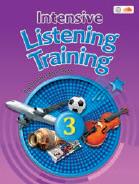


Features



• Thematically organized vocabulary including common spoken collocations
• Listening tasks developed around individual sentences, short dialogs, and short talks
• Graded practice materials to support listening skill development for high-beginning to intermediate learners
• Conversational dialogs and short talks written in natural English
• Dictation activities to reinforce listening skills










• Full transcripts included in student book





46 LISTENING MP3 Files Downloadable Resources: www.seed-learning.com/ILT Free Online Program (See p.74) Answer Keys Tests ★については下記までお問い合わせください。 Please contact the following regarding ★ E-mail : contact@tryalogue.co.jp ★★
Student Book
Key Words & Key Expressions
Target words or collocations for learners to listen for throughout the unit
Listening Practice
One dialog and one short talk to check listening comprehension of factual and implied information.









Listening Test


















Dialogs and short talks to assess learners’ listening comprehension skills up to their present point of study


Warm-Up, Listen for It, & True or False

Warm-up and Listen for It focus on listening at the sentence-level, while True or False focuses on short conversations and comprehension in preparation for the longer listening texts found on later pages.




Dictation 1




Reproduces the sentences, dialogs, and talks from the Listening Practice and Listen for It activities to give learners repeated listening practice of the unit’s material














Dictation 2




Reproduces the dialogs and talks from the Listening Test pages to give learners repeated listening practice of the unit’s material





LISTENING LISTENING PRACTICE RA 007 Listen and choose the correct answer. 1. Who is the woman speaking to? (A) Her father (B) Her husband (C) Her son (D) Andrew 2. How old is Andrew? (A) One month old (B) Eight months old (C) One year old (D) Nine years old 3. Why is the man surprised? (A) It’s the woman’s birthday on Friday. (B) The woman bought him a birthday present. (C) The woman didn’t invite him to a party in March. (D) The woman and her sister have birthdays in the same month. 4. How old is the woman’s sister? (A) The same age as the man (B) The same age as the woman (C) One year younger than the woman (D) Eight days younger than the woman 5. Who is Bill? (A) Sharon’s wife (B) Ken’s son (C) Tim’s brother (D) Tim and Ken’s father 6. How many children are there in Bill’s family? (A) 0 (B) 1 (C) 2 (D) 3 DICTATION 1 RA 008 A B M W M W M W M C Unit 8 Family Listen and ll in the blanks. 1. She’s very She and always me with my 2. don’t have any so I’m very my She’s than me, but our are each other. 3. She’s a person. She and my have been married for over 4. My and have only Kelly is and hardworking. He’ll make a someday. 5. They are the important in my life. My and love being We can’t wait to be someday. Listen and ll in the blanks. morning, Good Paul. Mom, old is ? Andrew is now months Do you another ? No! Do you or sister? really. Listen and ll in the blanks. Hello. to meet all. am Bill Reed, this is my Sharon. have two Our Tim, is and baby, Ken, is just six We to have a soon. 1 9 KEY WORDS C Listen for these words and phrases. parent brother sister grandparent apart years old daughter son close to children KEY EXPRESSIONS C Listen and match each question with its correct answer. 1. How old is your sister? (A) No, it isn’t. 2. Do you live with your grandmother? (B) don’t have any brothers. 3. Are you the youngest in your family? (C) Yes, we do. 4. How many brothers do you have? (D) She is 10 years old. 5. Is your school close to your home? (E) Yes, am. WARM-UP C LISTEN FOR IT TRUE OR FALSE RA
Unit 6 Unit 1: Family Listen and check who the speaker wants to talk to. 1. (A) Tina (B) Tom 2. (A) Jackie (B) Jack 3. (A) Grandparents (B) Parents 4. (A) Mr. Leese (B) Mr. Reese 5. (A) Sister (B) Brother Listen and check who the speaker is talking about. 1. (A) Her mother (B) Her father 2. (A) His sister (B) His brother 3. (A) Her mother (B) Her grandmother 4. (A) His son (B) His daughter 5. (A) His children (B) His parents Listen and write T for true or F for false. 1. (A) Susan is 13 years old. (B) Susan has ve sisters. 2. (A) Tommy has a big family. (B) Tommy wants a new bicycle. 3. (A) Harry and Jane have three children. (B) Becky has two brothers. 1 7 LISTENING TEST Listen and choose the correct answer. 1. Who does Laura meet? (A) Steve (B) Ryan (C) Beth (D) Her sister 2. How does Steve know Beth? (A) He is her brother. (B) They are best friends. (C) They go to the same school. (D) He is her boyfriend. 3. How old is Randy? (A) 6 (B) 15 (C) 16 (D) 60 4. Where do Randy’s grandparents live? (A) With Randy (B) In a di erent town (C) With their parents (D) In Glendale 5. Who is Benny speaking to? (A) His sister (B) His father (C) His best friend (D) It doesn’t say. 6. How many brothers does Benny have? (A) 0 (B) 1 (C) 2 (D) 4 DICTATION 2 C A M W M W M W M B C W M W M W M Unit 10 Unit 1: Family Listen and ll in the blanks. I’m Steve. Are Laura? Yes. My Laura Ryan. Laura. meet you, Beth Ryan’s ? Yes. Do ? We go to the school. Listen and ll in the blanks. everybody. Let me myself. My name’s I’m 16 There in my family—my parents, two and me. We live Glendale. My also but they Listen and ll in the blanks. How are in your Benny? are my and my Wow! Don’t have any ? I’m not. I’m the only Are you very any of ? guess I’m to my 1 11
Family
47
www.seed-learning.com/ESFS


EASY SPEAKING FOR SPEECHES
Level: Beginning
Easy Speaking for Speeches is a three-level introductory series designed to develop the public speaking and presentation skills of English language learners in elementary school. Each unit features an original video presentation organized, written, and delivered by a student presenter. These video presentations utilize helpful sentence patterns that can be used by students to create their own unique, polished presentations. Students who complete this series will gain con dence in speaking while developing language skills they can apply to reading, listening, and writing tasks in other classes.


Features
• Wide variety of topics related to school subjects and daily life
















• Guided exercises and activities allowing students to organize and prepare their own presentations
• Multiple sample speeches providing ideas for students to incorporate in their own speeches

• Fundamental speech patterns and sentence structures highlighted in each unit to build students’ written and oral language skills
• Repeated recycling of useful kid-friendly vocabulary
• QR code links to video presentations given by elementary-age students
Word TestとSample Lesson Planのご用意もございます。
詳細については下記までお問い合わせください。





Word Test & Sample Lesson Plan also available. Please contact the following for details. E-mail : contact@tryalogue.co.jp
Student Book
Getting Ready
This activity introduces students to the unit topic using a question and sample answer.
Partner Practice
This is a quick speaking activity that highlights a grammar point and/or clarifies vocabulary.
Key Expressions
The first half of the page begins with a partner activity that introduces three sentence structures. The second half of the page provides key vocabulary items that can be used in the target sentence structures.
MP3 Files Answer Keys Downloadable Resources: PPT One Thing About Me 01 UNIT Look and listen. B Show a number. Your partner says it. My name is Sam I’m eight years old. grade. Getting Ready A Listen and repeat. Partner Practice Who are you? 01 A Listen, read, and say. Then talk about yourself. Key Expressions June Jack Hi. My name is seven years old eight years old 2. I’m third grade fourth grade 3. I’m in B Listen and read. Add your own ideas. Then practice. draw do taekwondo dance dog cat hamster strawberries bubble tea 1. have a 3. for fun.
SPEAKING
48
Pair Work

The first activity incorporates key questions that are answered by the content of the presentation. With pair work, students gain confidence speaking with one another before giving their presentations in front of the whole class.
Presentation
Students watch a model presentation given by a native English student. This allows students to learn from a peer and feel confident when giving their own presentations.
Your Turn
Students begin the guided process of preparing their personal presentations.
Portfolio














Final Draft
At the top of each Final Draft page, students will find an additional example speech. This example supports creativity and reminds students of useful sentence patterns.
Study





This page provides students with a variety of examples of sentence patterns and vocabulary they can use to express themselves. It also provides fluency practice and enables learners to become confident speakers.











Speaking Tip





This section includes a useful tip to help students improve their public-speaking skills.









More Expressions
Here students are exposed to additional vocabulary and/or sentence patterns that will help them with their own presentations.
First Draft














This page provides a guided framework that allows students to write the first draft of their speech. It helps students prepare the introduction, body, and conclusion of their speeches.



















Presentation Notecards


If students need additional assistance memorizing their presentations, there are guided Presentation Notecards. On the other side of each notecard, there is space for students to attach their visual aids.























SPEAKING My name John. It’s nice to meet you. year years old. I’m in second grade. want to share one thing about me. 4. like likes banana milk. name is It’s nice to meet you. I’m old. I’m grade. want to share one thing about me. Pair Work A Listen and repeat. B Now ask and answer with your partner. C Circle and say. Then write your own ideas. What’s your name? How old are you? 3. What grade are you in? 4. What is one thing you want to share about yourself? My name is Kim I’m eight years old. I’m in third grade. have a dog named Bruce My 8 01 sing for fun have a cat Kelly 7 / 2nd / like chocolate Study A Practice and say. B Read. Then practice each speech with your partner. My name is years old. second grade. want to share something about myself. play soccer for fun. My name is Taylor years old. grade. want to share one thing about myself. garlic bread My name is Drew I’m eight years old. I’m in third grade. want to share a little about myself. My name is I’m years old. I’m in grade. want to share one thing about myself. 1. 1. 3. 2. 3. 9
Your Turn Plan your speech. One Thing About Me 1. What’s your name? My name is 2.How old are you? I’m years old. 3. What grade are you in? I’m in grade. What do you have? have What do you like? like What do you do for fun? for fun. 4.What is one thing you want to share about yourself? Choose one. 12 01 First Draft A Write your speech. Title Opening My name is years old. grade. want to share one thing about me with you all. have (a) Closing What grade are you in? What one thing you want Opening Ideas Hi. Hello. Good morning. It’s nice to meet you all. Closing Ideas B Practice your speech and write your Final Draft in your Portfolio Then give your speech. Unit 13
01 UNIT One Thing About Me Final Draft Example Good afternoon! I’m Mike. I’m seven years old. I’m in second grade. want to share one thing about myself. like chocolate. It’s delicious! Thanks for letting me share. One Thing About Me Opening Body 1. My name: 2. My age: My grade: One thing to share: Closing 01 UNIT
Presentation One Thing About Me A Watch the presentation. Listen carefully. Hi, everyone. My name is I’m years old. I’m in grade. want to share one thing about me with you all. like like them a lot! Thanks for letting me share. eight ten 4. French fries snacks Word Bank B Watch the presentation again. Write the missing words. 01 UNIT Speaking Tip Check the correct picture. More Expressions Practice the expressions. Check the things that are true about yo have a goldfish smartphone bicycle like chocolate flowers hamburgers for fun. sing play board games do puzzles Don’t talk like robot! Make sure your voice goes up and down. TIP Talk like a robot. 1. Talk like a person. 2.
49
www.seed-learning.com/SFS2E
SPEAKING FOR SPEECHES SECOND EDITION
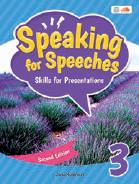

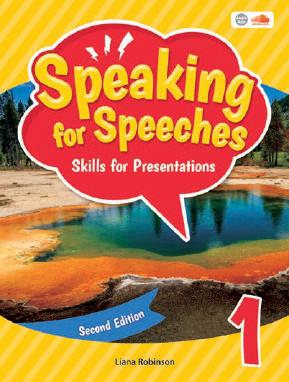
Level: High-Beginning to Intermediate
The second edition of Speaking for Speeches: Skills for Presentations is a three-level series designed to develop the public speaking skills of English language learners at the high-beginning to intermediate level. Each unit in the Speaking for Speeches series includes twelve parts plus additional speech preparation and evaluation materials. These parts work together to guide students through the process of creating and delivering their own unique presentations. There are two key video features of each unit. One feature is an exclusive video of a skilled student presenter. The other is a natural, unscripted student free talk. This series is designed to give students the skills and con dence they need to successfully speak in front of an audience.
Features
• Wide variety of speech topics ranging from informative to entertaining personal stories
• Sca olded exercises and activities allowing speakers to organize their ideas and prepare their presentations
• Abundant sample speeches and presentation ideas
• Guided speech patterns with useful sentence structures
• Repeated recycling of high-frequency vocabulary
• Unscripted student interviews presenting natural speech patterns
• QR code links to original presentations given by talented student presenters
50
SPEAKING Teacher’s Slides Teacher’s Guides MP3 Files Answer Keys Downloadable Resources: CEFR A1 – A2 Low A2 Low – A2 High A2 – B1 Low Speech Word Count 30-5540-6550-75100-120115-135130-150180-220220-260 Easy Speaking for Speeches1 2 3 Speaking for Speeches 1 2 3 Speaking for Presentations 1 2 CEFR Level New
Student Book


Getting Ready
The first page in each themed unit introduces vocabulary, expressions, and sentence structures students will find useful when creating their own presentations.
Presentation
The Presentation page features a video intended to show students what their peers are capable of and to encourage them. The speakers in the videos are students from diverse backgrounds.





Brainstorm


The two Brainstorm activities are meant to generate ideas without placing importance on sentence structure or grammar. This is where students should focus on creativity.
Final Draft
The Portfolio is where students write their Final Drafts. Each Portfolio page features an additional example.
Pair Work

















The second page of each unit focuses on speaking and helps students develop their own ideas about the topic.

Tip














This section also includes a useful tip to help students with their presentations.


























Guided Questions







Parts A & B feature guided questions and sample answers that help students prepare for their own presentations. This page also gets students thinking about how they can personalize their own presentations.

Free Talking






This unscripted free talking section is an informal response to the topic. It increases exposure to natural speech patterns and body language, aids in listening comprehension, and gives further ideas for students’ speeches.






















First Draft







The last page of the unit, the First Draft, helps students prepare their own speeches by using the writing prompts or creating original material.
Presentation Notecards
Guided Presentation Notecards are provided with the Portfolio to aid students in memorizing their speeches.
SPEAKING Getting Ready UNIT 01 About Me A Listen and write the correct letters. Not all choices will be used. a. read b. take a nap c. listen to music d. play computer games dance f. relax 1. 2. 3. g. do things with my friends h. study i. watch movies j. play soccer spend time with my dad 5. 4. 6. What do you school? What else do you like to do after school? watch listen after like also relax things music 1. like to to after school. 2. like to do with my friends school. 3. also to TV after school. like to after school. B Listen and complete the sentences. listen 6 UNIT 01 A 2. Listen and repeat.
Presentation A Watch the presentation. Listen for the key phrases. About Me was born also like years old Key Phrases Hello! My is Jennifer Falcon. My friends call me Jenny. Today, I’m going to tell you a little bit about myself. was born in a small in California called Sonora. You can see it in these pictures. We moved here to Los Angeles four years ago. I’m twelve old, and I’m in grade. like to do things with my friends after We usually play computer games. like to play basketball. Lastly, like really want one, but we can’t have a horse in the city. Now you know a few things about me. for letting me share. B Watch again and complete the notes. name 8 Guided Questions 01 B A My full name is Watch and choose the correct answers. 05 Take turns asking and answering the questions above with a partner. Read and answer the questions. 1. What’s your full name? My full name is Michael James Tatum. 2. How old are you? I’m eleven years old. 3. What grade are you in? I’m in fifth grade. What are your favorite animals? Monkeys are my favorite animals. What do you like to do? Who do you like to do things with? like to do things with my best friend Paul. What is one thing you want? really want a new phone. a. 14 b. 15 2. What are her favorite animals? Pandas b. Horses Talking
Brainstorm Call me Was born Like 1 Like 2 B Complete the mind map. There is space to add to the map if needed. Age Grade Name play soccer do things with my friends take a nap dance play computer games watch movies watch TV study spend time with my dad read play the guitar A Think about introducing yourself. What do you like to do? IDEAS Your Ideas 10 First Draft UNIT 01 A Portfolio Introduction Conclusion Body About Me Write your first draft. See the for more ideas. My name is My friends call me Now you know Today, I’m going to I’m years old, and I’m in grade. I/We usually
Portfolio Portfolio About Me UNIT 01 Example Hi! I’m Kevin Choi. It’s nice to meet you. You can call me Kev. I’m going to tell you a little bit about myself. was born in big city in Canada called Toronto. We moved here to Tokyo two years ago. I’m eleven years old, and I’m in fifth grade. like to do things outside after school. usually play baseball with my friends. also like to skateboard. Lastly, like computers. really want a new one, but my parents won’t pay for it. I’m saving my money! Now you know all about me. Thanks for listening! 91 Portfolio Use big letters. The words should be large enough to read with your notecard held at arm’s length away from you.
51
www.seed-learning.com/SFP
SPEAKING FOR PRESENTATIONS
Level: High-Beginner to Intermediate
Speaking for Presentations is an innovative two-book series designed to develop the public speaking skills of adolescent and adult English language learners at the high-beginning to intermediate level. While helping students gain con dence and improve their public speaking abilities, the series gives students a detailed guide to the delivery of great speeches and the preparation of dynamic presentations. This series will prepare students for any kind of speaking from casual descriptions of personal experiences to more formal, research-based presentations. Central to each lesson is an original presentation organized, written, and delivered by a student presenter. With its contemporary approach, the series helps students make noticeable improvements. Speakers acquire pragmatic speech communication skills through guided, systematic practice. The skills learned in this series will be useful to students for the rest of their lives—both in professional and personal speaking opportunities.
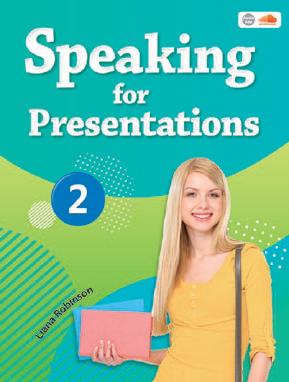

Features
• Wide variety of speech topics ranging from informative speeches to entertaining personal stories
• Well-ordered exercises and activities allowing speakers to organize their ideas and prepare their presentations
• Guided speech patterns with useful sentence structures
• Continual recycling of high-frequency vocabulary
• QR code links to real-life videos of sample speeches and presentations illustrating e ective presentation techniques
Downloadable Resources:
MP3 Files Answer Keys Videos Presentations PPT
SPEAKING Cue Cards 52
SPEAKING

Student Book

Listen














This page introduces students to the unit topic with a variety of interactive activities. It also gets students to begin thinking about what they will say in their own presentations.




Speaking Tips and Expressions



























To improve their delivery, students are given three tips to practice while preparing for or giving their speeches. Students are also exposed to additional expressions and sentence structures that help to provide a framework for their own speeches.
Language Practice

The first half of the page begins with a two-person language activity that introduces key vocabulary/ terms and sentence structures. The second half of the page ends with personalized questions that encourage students to talk about their own ideas or opinions. Within the first two pages of each lesson, students are exposed to several topic/content ideas in preparation for their own speeches.
Interview
Here students are given quick speaking activities featuring key language to get them comfortable speaking in pairs before giving their presentations in front of the whole class.


Presentation

Students watch a model presentation given by a real student in a classroom. This allows students to learn from a peer and feel confident when giving their own presentations. First, students watch and listen for key words. After that, they complete the script or note-taking activity which provides a framework for their own presentations.
Video QR Codes









The QR codes provide a way for students to watch actual videos of ESL student performers. Students can observe the verbal and non-verbal cues given by the presenters.
Write









Students finalize their topic choice and brainstorm about their own speeches. Next, a guided framework allows students to consolidate those ideas into a speech featuring an introduction, body, and conclusion.
Present

At the end of the unit, students will be ready to make their own visuals and give their presentations in front of their peers.

A Listen and check. B Talk to your classmates. 2. Name Milo Age 16 17 18 Favorite things to do play computer games listen to music hang out with my friends sing karaoke Name Jana Age 18 19 20 Favorite things to do dance play the piano relax study paint What’s your favorite thing to do? Why? My favorite thing to do is swim is good exercise, and like being in the wate Listen Introducing Myself Unit 1 Ideas play tennis go hiking talk with my friends 6 A Practice the language options. Say them aloud, and then practice with a partner. B Discuss the questions with your classmates. Write down your ideas. My major is/I want to study . because . the experiments are fun want to cure diseases science like helping people like reading and writing law can be creative want to be a painter art can get a good job want to cure diseases business most jobs use computers programming is fun computers the past is interesting it is easy to understand history 1. What are some other school subjects? Why do we study them? Subject: Why: Subject: Why: 2. What are some fun things to do? Why are they fun? Thing to do: Why: Thing to do: Why: Language Practice Unit 7
A Watch the presentation. Listen for the key phrases. B Watch again and complete the script. Hi! My is Richard, but you can call me Ricky. Today I’m going to tell you a little bit about myself. was born in a small in Florida. You can see it in these pictures. This is my parents’ house. They still live in it. moved to New York this year for school. love living in a big city. It’s a lot of fun. There are so many to do and places to go. I’m nineteen old, and I’m in my first year of university. don’t have a but like 6 and sports. want to study education. want to be a science teacher and a coach. But my father is a and he wants me to be a doctor, too. I’m not sure what to choose. In my free time, like to play It’s my favorite thing to do. play it all the time. also like cats. really want one. But we can’t have any in the dorms. Someday, will have a cat. I’m sure of it! Now you know a few things about me. for letting me share. Presentation KeyPhrases was born years old major also like first year of university favorite thing to do 10 A Think about introducing yourself. Who are you? C Practice. Then give your presentation in front of the class. Major/Want to study: Why: Favorite thing to do: Why: Age: Introducing Myself B Write your own presentation. See page 75 for more ideas. Introduction Hi! My name is Today I’m going to Body was born I’m years old, and I’m My favorite thing to do in my free time is also like Conclusion Now you know a few things about Thanks for letting Write Did you walk with confidence? Did you look comfortable? Did you stand up straight? How did you do? Unit 11
A Discuss the speaking tips. Practice the techniques. B Read through the expressions. Then practice them with a partner. Walk to the front of the Set your feet, and stand up straight. Don’t put your hands in your pockets or cross your legs. Hi! Hello everyone! Good morning! 1 was born in Mexico Rome, Italy 3 My name is Joel Brown I’m Lisa My name is Michael but you can call me Mike 2 My major is science want to study law I’m interested in computers and art 4 Thank you! Thanks for letting me share. Now you know a few things about me. 5 Speaking Tips and Expressions A Read through the interview. Then role-play with a partner. B Interview three of your classmates. Use the questions from above. Sample Answers Partner Partner 2 Partner 3 Question 1 2 3 4 5 Canada city 18 computers relax What country were you born in? Were you born in a city or town? How old are you? What is your major? What is your favorite thing to do? was born in a small town am nineteen years old. My major is business My favorite thing to do is watch TV Interview
53
www.seed-learning.com/HG
HAPPY GRAMMAR
Level: Beginning to Low-Intermediate
Happy Grammar is a four-level series designed for emergent students of English, and it focuses on fundamental grammar structures. The books explain elementary grammar theories with helpful illustrations and photographs. The aim of the series is to teach the beginning principles of grammar, correct usage, and composition. The kid-friendly layout and interesting activities encourage students to participate. The series can be used at home or in the classroom, and it contains an abundance of useful exercises which give students the opportunity to consolidate what they have learned.




Features

• Easy-to-follow lessons organized by how students naturally learn
• Clear explanations with useful illustrations and realistic examples
• High-frequency vocabulary and sentence patterns


• A wide variety of exercises that make learning fun
• Review sections and exams included
















• Pull-out workbook included







GRAMMAR Tests Answer Keys Downloadable Resources: Word Lists Free Online Program (See p.74) MP3 Files PPT 54
Student Book
Grammar Target
Gives a short explanation of the grammar objective in clear, concise language. Then provides a visual representation of the grammar concept with interactive practice.
























Lesson 2
Lesson 1














Grammar Tip
Gives additional information about the grammar target.




































































Lesson 2
The first book in the series uses two pages to provide an interactive practice platform where students can actively learn the grammar concept. Later books condense this down to one page and give more practice exercises.


Exercises
A variety of practice exercises are used throughout the book. They are interesting, fun, and easy to understand. Here you can see that many di erent activities appear in Lesson 1 and Lesson 2.





GRAMMAR Articles Do not use articles or the before a name. a girl the smart girl ( an Angela a city the big city the Hong Kong an alligator the hungry alligator an egg the blue egg the Paris G Tip 1. A + Regular Noun house boy city 2. An + Noun Starting with A, E, I, O, or U apple owl 3. The + Specific Noun the the the yellow house 12 Unit Lesson2 1 A Look and circle. B Write the or an / the tall girl 1. a / an bird 2. a / the moon 3. a / an elephant 4. an / a orange 5. a / the old ball 6. an / the yellow store 7. a / an artist 8. a. ambulance b. Dr. Perez 1. a. umbrella b. 2. Great Wall b. China 3. b. USA 4. 13 Lesson 2 Exercises
Look and write. 1. People 1 4 2 5 3 6 boy father girl mother family teacher family 2. Places 1 4 2 5 3 6 city farm house park school store park 8 Singular Nouns Unit Lesson1 1 3. Things 4 2 5 3 6 apple bag desk pencil shirt toy pencil 4. Animals 4 2 5 3 6 bear bird cat dog turtle tiger cat 9 Lesson 1
A Look and circle. tiger / turtle 5. farm / park 6. shirt / toy 7. boy / girl 8. house / store 1. mother / father 2. bear / bird 3. apple / banana 4. Names are nouns. Names start with a BIG letter. Gramm T ip boy Alex doctor D L city Paris, F dog Bingo 10 Exercises B Look and circle. Mrs. Smith / woman Ray / boy Julia / girl Mr. Smith / man Mimi / cat 1 Name: 3 Noun: 5 4 Julia C Look and write. worm / Worm 1. jo’s hamburgers / Jo’s Hamburgers 2. flower / Flower 3. restaurant / Restaurant 4. mrs. parks / Mrs. Parks 5. farmer / Farmer 6. Lesson 1 11 Lesson 1
cook egg farmer moon nurse orange airplane sun C Write and match. 1. a banana 3. the David 5. a igloo 7. a Italy 2. 4. an elephant 6. Helen 8. a kangaroo D Is it correct? Write 1. 2. 3. 4. 5. 6. 7. 8. nurse a an the 14 Exercises airplane ambulance elephant lemon orange E Read and circle. F Look and write. 1. The pink eraser 2. The small ball 3. The old shoe A girl, an and the 1. An a bird, and the 2. An a lime, and a 3. An a man, and a 4. 15 Lesson
55
www.seed-learning.com/1200KEW
1200 KEY ENGLISH WORDS


Level: Beginning
1200 Key English Words is a three-book series designed to provide a solid foundation in vocabulary for a wide age range of beginners. The words chosen for the series come from an analysis of the most commonly found words in textbooks and materials for English language learners. The 400 words presented in each level provide learners with 1,200 practical, high-frequency English words. This invaluable classroom resource for balanced literacy boosts reading, writing, and spelling skills and prepares students for academic success.

Features
• Useful photographs that illustrate each target word
• A wide variety of exercises that make learning fun and interesting
• Correct pronunciation of target words indicated with phonetic symbols

• Common sentence patterns
• Special thematic units
• Quarterly reviews
• Korean, Japanese, and Chinese language de nitions available on Quizlet
• MP3 audio for download



MP3 Files Answer Keys Downloadable Resources: Word Lists Quizlet SoundCloud
VOCABULARY
Free Online Program (See p.74) Tests 56
Student Book


New Vocabulary




























There are two New Vocabulary sections per unit. Each section features ten words. For each word, students see an interesting photograph and read a sample sentence to go along with that photograph. There is also an additional collocation provided for each word. This additional lexical information is useful for memory retention and fluency. These pages also provide parts of speech and pronunciation guides which give students all the tools they need for success.













Practice
Each Practice section focuses on the ten New Vocabulary words from the previous page. The activities featured on these pages have a variety of fun exercises. Through the use of photographs and sentences students see the words in multiple contexts. This helps students broaden their understanding of each word and makes it easier for them to use the new words themselves.



Activities







Here students practice all twenty vocabulary words together. Students solidify their new knowledge by actively practicing the new words.
Bonus Theme Units



There are four Bonus Theme Units per book. The words are linked by theme and hidden in a colorful illustration.































































VOCABULARY
New Words Unit 1 ball [bɔl] They have three balls a red ball 1 go [ oʊ] go with my mom. go home jump [ ʌmp] The dog is jumping jump up and down 3 play [pleɪ] They play a game. play with a ball read [rid] We read our books. read to me 5 see [si] see a boy. see you again ship [ ɪp] The ship is white. on a ship 7 sleep [slip] The boy is sleeping sleep well toy [tɔɪ] He plays with his toys a fun toy 9 want [wɑnt] He wants the cookies. want more Learn the words. 8 Practice Unit 1 1 a. He goes on a ship. b. He plays with a ship. 3 a. We see a dog. b. We play with a ball. 2 a. He wants a book. b. He reads a book. 4 a. The cat plays with a toy. b. The cat is sleeping. Check the correct sentences. A 1. We with a ball. 2. They play with their 3. The girl a book. 4. They up and down. 5. The boy in a car with his dad. reads goes play toys jump Complete the sentences. B play 9 New Words fly [ aɪ] The bird is flying fly high 11 get v. [ ɛt] gets get an A learn [lərn] They are learning learn English 13 meet v. [mit] meeting the boy. nice to meet you [neɪm] His is Ben. 15 say v. [seɪ] says “Hi!” say a word sit [sɪt] She sits with her dad. sit down 17 stand v. [stænd] standing stand up [ z] He is using a pencil. 19 walk v. [wɔk] They are all walking walk fast Learn the words. Hi! 10 Practice get name learning says read Complete the sentences. Find and check the secret word. B 1. Sam s a y s “Hi, Mom!” 2. We a pizza. 3. Katie is to fly. 4. What is your ? 5. a book. The secret word is: Unit 1 1. The boy is sitting with her mom. The boy meets b. a pencil. 3. She is walking c. in the car. 4. She is using d. the girl. Match the sentence parts. Then number the pictures (1-4). A 1 b 11 Activities read want sleep learn fly see go say 5. 6. 7. 8. Write the words under the pictures. A 1. The dog up and down. a. sees b. jumps c. meets 2. We go on a a. ship b. ball c. name 3. She on her feet. a. wants b. says c. stands 4. He a pen. a. walks b. uses c. flies 5. We with toys. a. sit b. get c. play Circle the correct answers. B Hi! 12 Her is Mary. She goes on a She birds. They are ship flying name sees Unit 1 She is sitting. 2. She is not standing. T F 3. She has a toy. T F 4. He is reading a book. T F 5. He is walking. T F 6. He is jumping. T F Circle T for true or F for false. D Complete the sentences. C Her name is Lisa. His is Paul. Lisa Paul. They “Hi.” They to play. They can play with want name ball say meets 13 Fruits and Farm Bonus 1 apple [ˈæpl] apricot ɪprɪˌkɑt] banana [bəˈnænə] grapes reɪps] lemon [ˈlɛmən] melon [ˈmɛlən] papaya [pəˈpaɪə] pear [pɛr] pineapple [ˈpaɪˌnæpl] strawberry [ˈstrɔˌbɛri] 6 7 8 9 10 Find and circle the hidden pictures. 32 Fruits and Farm chicken [ˈ ɪkən] cow [kaʊ] duck [dʌk] fence ɛns] goat oʊt] horse [hɔrs] rabbit [ˈræbət] sheep ip] shovel [ˈ ʌvəl] snail [sneɪl] 6 7 8 10 Find and circle the hidden pictures. 34 57
www.seed-learning.com/4500KEW/
4500 KEY ENGLISH WORDS




Level: Intermediate
4500 Key English Words is a four-book series for intermediate students, designed to reinforce and expand their foundation of vocabulary. The words chosen for the series come from an analysis of the most commonly found words in textbooks and materials for English language learners. The words presented in each level of 4500 Key English Words , when combined with the vocabulary words covered in its partner series, 1200 Key English Words , provide students with a working vocabulary of 4,500 practical, high-frequency English words. This invaluable classroom resource for balanced literacy boosts reading, writing, and spelling skills and prepares students for academic success.
Features
• Useful photographs that illustrate each target word
• Clear, easy to understand de nitions and examples


• A wide variety of exercises to reinforce target vocabulary
• Correct pronunciation of target words indicated with phonetic symbols
• Common collocations and sentence patterns
• Reviews after presentation of 100 new words to consolidate learning
• Original texts which utilize target words presented at the end of each Review
• Appendix of pre xes and su xes
The
Resources: Quizlet SoundCloud MP3 Files Answer Keys Word Lists Tests
VOCABULARY Downloadable
Titles 40080012002000280036004500530061007000 1200 Key English Words 1 2 3 4500 Key English Words 1234 7000 Key English Words 1 2 3 Vocabulary Levels (400 New Words/Level) (800 New Words/Level) (800 New Words/Level) 58
Key English Words Series Levels
Student Book
New Words


























































There are two Learn the words sections per day. Each section features ten words with a photograph and sample sentence. There is also an additional collocation provided for each word. This extra lexical information is useful for memory retention and fluency. These pages also provide parts of speech and pronunciation guides. Teachers should begin by pronouncing each word and encouraging students to practice their pronunciation. Then teachers may choose to read the sample sentences aloud or have students take turns reading the sentences. Talk about the photographs while doing this.


Review Units





















After every five units, students are presented with a four-page review unit which provides extensive practice and review of the words from the previous five units. Students solidify their new knowledge as they encounter these words in a variety of new contexts. Students can complete these units at home, as homework, or in class, either alone or with a partner.





Practice Exercises
Exercises 1 & 2 focus on the ten new vocabulary words from the previous page. The activities featured on these pages test the students’ recollection of meaning, ability to use the word in the correct context, and ability to interpret an image and match it to a relevant description. Through the use of photographs and sentences, students see the words in multiple contexts. This helps students broaden their understanding of each word and makes it easier for them to use the new words themselves. The Exercises pages end with a check of the students ability to translate the words into and from their first language. Students can complete these activities on their own or in small groups.
Appendix and Index









At the end of each book, students will find a list of useful English prefixes and su xes.


An understanding of the meaning of prefixes and su xes will assist students when they encounter new words. Each book in the series also features an index of all the words introduced in each day’s lesson.

VOCABULARY
Unit 1 Learn the words. 1 2 4 5 7 8 accept [ækˈsɛpt] She accepts a box. *to accept a gift basic [beɪsɪk] adj. simple; fundamental He can do basic math. *basic ideas chemical [ˈkɛmɪkəl] n. a substance used to make things *to mix chemicals difference [ˈdɪ ərəns] the way things are not like each other There is a difference in their heights. *no difference fuel [ˈ əl] something that makes energy when it burns He puts fuel in his car. *to get fuel liquid [ˈlɪkwɪd] a substance like water liquid *to drink liquids necessary [ˈnɛsəˌsɛri] adj. An oven is necessary for making cookies. *to become necessary for produce [prəˈd s] to make The tree produces flowers in spring. *to produce food stairs [stɛəz] steps She is sitting on the *to go up the stairs unite [ ˈnaɪt] v. to join The boys united to win the game. *to unite people 8 Exercises 1 Unit 1 B Complete the sentence with the correct word. 1. will get for my car. 2. Tea and coffee are a. basic b. necessary c. liquids d. fuels this gift. a. accept b. produce c. unite d. liquid 4. go up at school. necessary produce 5. The scientist is mixing a. basic b. accepts c. chemicals d. differences C Match the phrase with the correct picture. 3. a. necessary to add liquid b. basic stairs producing chemicals d. people uniting produce simple; fundamental 2. b. to join 3. basic to make the way things are not like each other A Match the word with its definition. 9 Learn the words. 12 13 16 19 20 although [ɔlˈ oʊ] conj. even though; despite Although she is hungry, she won’t eat. *Although there is/are breathe [bri She breathes deeply. *to breathe in/out concerned [kənˈs rnd] adj. worried They are concerned about money. factory [ˈ æktəri] a building where things are made factory produces chemicals. *to make (sth.) in a factory gas [ æs] n. a substance like air that can be burned as fuel We can cook with gas *to light gas harm [hɑrm] Reading in the dark harms material [məˈtɪriəl] a substance that things can be made from The man is cutting *a piece of material rare [rɛr] adj. not common This shop sells books. *a rare animal select [səˈlɛkt] Which should select wide [waɪd] adj. having a large distance from one side to the other The TV is wide *wide open 10 Exercises 2 Unit 1 C Complete the sentence with the correct word. select b. breathe concerned d. wide need a piece of gas b. factory material d. harm 3. We cook with in our kitchen. a. although b. concerned d. gas 4. The river is so we cannot swim across it. factory 5. Tom is poor, he is happy. Although 1. She is selecting a rare animal. 2. The burning gas we can’t breathe in fresh air. 3. Because of the factory, can harm you, so please be careful. a piece of material. Although he is tired, his eyes are wide open. B Match the phrases and number the pictures (1-5). 1. concerned a. a building where things are made to choose 4. select d. worried 5. factory to hurt A Match the word with its definition. 11 Units 1-5 Review 1 The factory increased its produce b. producible production d. produced 2. The musician will do his performance next time. differ b. different difference d. differently 3. A took my watch and phone. a. rob b. robber c. robbed d. robbing The high price of fuel my father these days. b. concerned d. concerning 5. Karl makes pottery. beauty beautifully beautify 6. The band’s concert was a great succeed b. successfully d. successful The passenger accepted two snacks. happiness b. happy unhappy d. happily 8. Our flight to Tokyo was very calmly B Choose the correct word form to complete each sentence. 1. Fruits and vegetables are full of You can see many 3. use languages when travel. There are lots of houses in my 5. A(n) is necessary for a musician. 6. The flash of frightened the woman. It’s a good idea to separate 8. A tree fell on the roof of my house. A picture (1-8). instrument statues neighborhood garbage vitamins lightning foreign b d 28 1 Things made by nature Things made in a factory Things you can watch honey honey drama chemicals lightning festival pottery plastic concert diamonds performance vitamins dust C Write the words that match the categories. Use the words in the box. 1. pretend getting the result you want 2. image b. the top layer of earth successful d. small pieces of dirt 5. lower a picture 6. root f. to move down 7. soil g. a part of a plant that is underground simple E Match the words with the correct definitions. 1. Remember to when the temperature is hot. 2. Most students to school. It is not good to 5. Pandas and tigers are 6. Although live in a city, live in breathe in carry a backpack rare animals a quiet neighborhood light the gas drink liquids D Write the correct phrase in the blank. 29 a trip on an airplane for one person a shape with a square base and triangular sides My sister has a good but forget things. a light meal need money, but have Down 1. of arts, music, and literature 4. the people watching a play, opera, etc. 6. Let’s buy some fruit at the 7. A car is made of glass, and plastic. F Complete the crossword. 1. The band has two female singers. There was a mysterious light in the sky. strange b. uncomfortable soil d. underground exactly 232 people in this building. b. branch precisely d. about 4. There was a lot of garbage in the park. gas Breathing in chemicals can harm you. greet b. disagree produce d. hurt G Choose the word most similar to the underlined word. 30 Bring It Together Review 1 Read the passage. A Successful Woman We all want to be successful. But what is necessary for us to do well? First, find things that you are talented at. Next, decide what brings you happiness. Then will not be easy. There will be various difficult times. When things seem bad, don’t give up. One successful person was Frida Kahlo. Her life was not easy at all. But she did not give Frida Kahlo was a female artist from Mexico. When she was six, she got very sick. One of her legs was children were unkind and made her feel uncomfortable at school, but her father encouraged her to play sports. Frida was a very good student and she wanted to become a doctor. But when she was eighteen, she was in a bus accident. Her legs were hurt in the accident. While she was in the hospital, she began to paint. She found that she was talented at painting! She met a famous artist and showed him her art. He said that it was very good, so she decided to become an artist. She traveled a lot in Mexico and the United States. Her work had Soon people knew Frida’s work in Europe, too. Sadly, Frida did not live a long life. But we can still see her work these days. But Frida’s story shows us that To be successful, you should select a goal. Frida Kahlo was a male Mexican artist. 3. Frida’s art had many cultural images within it. 4. Frida Kahlo was talented at painting. A Write T for true or for false. Which word means hurt? 2. Which word means pictures? 3. Which word means choose? B Find the underlined word in the passage with the closest meaning. 31
59
www.seed-learning.com/7000KEW
7000 KEY ENGLISH WORDS



Level: Advanced
7000 Key English Words is a three-book series designed to provide learners with an essential foundation of commonly encountered English words found in both spoken and written English. The eight hundred words presented in each level, combined with the vocabulary words covered in its partner series, 1200 Key English Words and 4500 Key English Words provide students with a working vocabulary of 7,000 practical, commonly encountered English words.
7000 Key English Words is divided into forty units. Each unit introduces twenty new words accompanied by a pictorial representation, pronunciation guide, sample sentence, word stem information when available, and an example of a collocation. 7000 Key English Words will prepare students to read, understand, and use English e ectively, while enriching and expanding their vocabulary at the advanced level.
Features
• Useful photographs that illustrate each target word
• Clear, easy to understand de nitions and examples
• A wide variety of exercises to reinforce target vocabulary
• Correct pronunciation of target words indicated with phonetic symbols
• Common collocations and sentence patterns to increase student understanding and ability to use target vocabulary
• Useful word stems provided to enhance recognition of familiar word parts and facilitate learning
• Review units after presentation of every 100 new words to consolidate learning
• Original texts which utilize target words presented at the end of each Review
• Appendix of common word stems, pre xes, and su xes
• Index of all target vocabulary to allow students to nd words quickly
Downloadable Resources: MP3 Files Answer Keys Word Lists Tests
VOCABULARY New 60
Student Book
New Words


























Each section features ten words. For each word, students see an interesting photograph and read a sample sentence to go along with that photograph. There is also an additional collocation provided for each word. This additional lexical information is useful for memory retention and fluency. These pages also provide parts of speech and pronunciation guides. Word stem information is also provided for many of the new words.




Review Units























After every five units, students are presented with a four-page review unit which provides extensive practice and review of the words from the previous five units. Students consolidate their new knowledge as they encounter these words in a variety of new contexts.











Practice Exercises
Practice Exercises 1 & 2 focus on the ten new vocabulary words from the previous page. The activities featured on these pages test the students’ recollection of meaning, understanding of the usage of each word, and the ability to use the word correctly in a new context. Through the use of sentences and short passages, students see the words in multiple contexts. This helps students broaden their understanding of each word and makes it easier for them to use the new words themselves.
Appendix and Index



At the end of each book, students will find a list of twenty-five useful word stems used in English. An additional list includes some of the most common a xes that are added to word stems to create words. Knowing the meaning of these stems and a xes will assist students when they encounter new words.

VOCABULARY
Practice 1 Unit 1 abrupt [əˈbrʌpt] adj. sudden and unexpected, often unpleasant ➞ The accident occurred when the front car came to an abrupt stop. an abrupt slope chancellor [ˈt ænsələr] a person of high rank in a university or government in some countries Angela Merkel was of Germany for 16 years. a university chancellor confidential [ˌkɑn əˈdɛn əl] adj. secret or private Doctors must keep your information confidential be confidential mortgage money that the bank agrees to lend you to buy house ➞ We took out a mortgage of $250,000 to buy a house. to pay off a mortgage ambivalent [æmˈbɪvələnt] adj. being unsure of how you feel; having two opposing feelings about healthy eating. highly ambivalent -val- (value) closure [ˈkloʊ ər] the act of stopping the operation of a business or organization The workers hope to prevent the factory a temporary closure disapprove to consider something wrong or bad ➞ The woman disapproves of her daughter’s hair color. strongly disapprove foresee [ ɔrˈsi] v. to realize or understand something before it happens be impossible to foresee a problem taken to law court to get a legal decision ➞ The judge finally made a decision in the lawsuit to bring a lawsuit legislate [ˈlɛd ɪsˌleɪt] Recently, the government is legislating against gas-powered to legislate for leg- (law) 8 1 Unit 1 A Match the words to their meanings. 1. legislate money that you borrow to buy a house ambivalent b. to realize ahead of time abrupt 5. foresee e. unsure of one’s feelings 6. mortgage f. to create a new law B Choose the correct words to complete the sentences. 1. The of the college library will be inconvenient for students. chancellor b. mortgage closure 2. missed my exam because did not that my bus would be canceled. legislate The woman brought a(n) against the man who ran over her dog. a. disapprove b. lawsuit c. optician 4. While not all American schools have a the University of California does. closure b. chancellor conception 5. The ability to is carefully controled. legislate disapprove C Choose the words or phrases which are closest in meaning to the words in bold. 1. My mother strongly disapproved of the holes in my jeans. stabbed b. foresaw disliked 2. The chancellor felt ambivalent about the recent protests against war. unflattering This information is highly so it must be password protected. a. ambivalent b. mortgage c. secret 4. When the supermarket roof collapsed, there was abrupt chaos. unexpected b. lawsuit closure 5. Although he was good at art at school, none of his teachers foresaw that he would become an artist. produced predicted 9 Practice 2 partisan [ˈpɑrtəzən] adj. showing strong support for one particular person, group, or idea attitudes can lead to fighting, and even war. partisan politics 13 [reɪv] to talk in a fast and excited way Lucy raved about the restaurant she ate at yesterday. to rave over 15 sober [ˈsoʊbər] adj. serious and thoughtful a sober expression 17 tabloid a newspaper with small pages, short articles, and often less Carrie likes tabloids because they are easy to read. in the tabloids whatsoever [hwʌtsoʊˈɛvər] used to emphasize an idea expressed in negative phrase ➞ She has no interest whatsoever in this book. nothing whatsoever 20 privatize [ˈpraɪvəˌtaɪz] to transfer a good or service from the public sector to private ownership ➞ These days many cities are privatizing waste management. privatize utilities n. privatization naïve [nɑˈiv] adj. lacking experience of life; too easily trusting of others was naïve to think didn’t need to watch my bag. 11 adv. naïvely, n. naïvety obstruct [əbˈstrʌkt] to make difficult or impossible for someone to move forward The parked car is obstructing to obstruct a view oba feeling or attitude People often express a negative homeless. public sentiment vanity [ˈvænəti] the state of being excessively concerned about and proud of one’s appearance Some believe that social media is impacting personal vanity great vanity 10 Practice 2 Unit 1 A Complete the words and match them with the correct definitions. 1. to block or put difficulties in the way of something serious and sensible b. excessive pride or interest in one’s appearance pr to transfer a business from public to private ownership 5. to speak in a excited and enthusiatic way ob 6. feeling or attitude f. B Check the sentence that is true. 1. a. You are naïve you send your bank account details to a stranger. b. You are naïve you put a password on your phone. 2. you obstruct someone’s plans, they will be pleased. b. You might rave about a movie if you enjoyed it. 3. Vanity is a quality that everyone likes in a friend. b. A sports referee must not be partisan and should treat both teams equally. 4. A tabloid often has photos of celebrities on the cover. b. Someone who tells a lot of jokes is a sober person. When a company is privatized, the government now owns it. You should not share confidential information online anywhere whatsoever. C Complete the passage using the words in the box. tabloids whatsoever partisan sober sentiment naïve Many people believe that is to believe everything you read in the Although they often claim to express public they are also known to tell lies with no hesitation They like to promote politics through their divisive articles. You should keep a mind and think critically before accepting the information they present. 11 Units 1-5 Review 1 major raved deliberate hassle simultaneous inventory unanimous tabloids presidency undermine A Write the missing letters to make the correct words. 1. Re health is important you want to start a family. nt is often in a lot of danger. 3. All sh have the right to cast a ballot at the annual meeting. The car came to an ab stop when the light turned red. 5. The magistrate had a query about the nt’s testimony. 6. The public disapproved of the chancellor’s ex The skeptic felt du about the government’s plan to improve gender equity. 8. The proprietor of the linen company made a pl to donate surplus materials to local schools. 9. The man lost his home when he te the payments on his mortgage. The plaintiff in the woman he was talking to, causing her to become hysterical. B 1. Many people about the movie, but it wasn’t that great. It is such a to pick up someone at the airport. 3. There were three tribunals taking place in the courthouse. 4. are not known for high quality journalism. The electorate knew the upcoming referendum might cause changes. 6. The person who holds the office of the hears a lot of confidential information. 7. Workers must be attentive when they are checking Partisan politics often the process of making new laws. 9. It was a choice to wear pants with an elastic waist to the dinner party. The caucus came to a decision. productive 28 Review 1 C Choose the correct word to complete each sentence. 1. He believes there’s no such thing as too much so he’s always in the news. a. jurisdiction b. publicity c. closure d. conception 2. The government decided to health care, and it became more expensive. deploy b. replicate privatize d. manifest Your skills have to be excellent if you want to be an actor. a. verb b. verbal c. perjury d. restitution 4. The branch of government has to do with courts of law. monopoly judicial The major snowstorm caused a lot of school alumni b. doctrines wardrobes d. closures 6. Fortunately, the army was able to my grandparents’ village in the war. impeach He became quite about romance after his last relationship ended. cynical b. velvet socialist d. tangible 8. wish my sister wasn’t such a about vaccines. a. statute b. skeptic c. demography d. breakdown D 1. sober a close and careful examination b. disgusting dirt or waste vanity to exchange 4. swap d. serious and sensible 5. dubious unsure if something is true 6. verbal f. concerned about one’s appearance 7. scrutiny g. a feeling a part of a cell which carries genes 10. chromosome j. to realize something before it happens 29 Vocabulary Words 1. confidential adj. confident adj. confide v. wish my kids would in me about their problems. 2. legislate legislative adj. legislature working on writing new laws. 3. defendant defend defense The boy tried to attentive adj. attention attend You need to pay to your teacher. nominate nominee nomination She was a for the Oscar for Best Actress. reproductive adj. reproduce reproduction Rabbits very quickly. ideological adj. ideology ideologically We often feel wary of people whose thoughts are different from our own. viable adj. viability viably The recent increase in our expenditures is threatening the our business. E Choose the correct word to complete each sentence. F Circle the correct words to complete the sentences. 1. Everyone else voted yes, but felt had to replicate dissent obstruct impeach the investigation by hiding evidence. 3. am studying coastal ecology demography because want to be a biologist. 4. We had to get a mortgage lawsuit from the bank in order to buy our house. 5. Elastic / Linen clothing is nice and stretchy, so it’s great for doing sports. because they are light and easy to read. The company had to pay restitution statute to the employees who were injured in the explosion. 8. The plaintiffs / shareholders decided to sell the company to an entrepreneur. 9. Many candidates are on the ballot beneficiary in this year’s election. 10. The electorate / reef was fed up with all the political infighting and corruption. 30 Review 1 Last year, was a correspondent for my school newspaper. love writing and want to study journalism at college. wrote about the election for class president. Three students nominated Each student had a different campaign. Student A used aggression. She intimidated other students and said that if they didn’t vote for her, her aides would spread lies about them on social media! Some students became hysterical and told the teachers. Of course, they disapproved of Student 1’s tactics. She was removed from the election. Student B made a pledge to have velvet curtains put in every classroom. She also promised that every student would get free donuts every morning. Her promises were dubious Where would the money come from? The students didn’t believe her ideas were viable. was certainly a skeptic when heard her speech. Student C got less publicity than the other two. She asked students to be kind to each other. She asked everyone to think about ecology and to waste less food in the school cafeteria. surplus clothes to the poor! She said that she had no interest in power On election day, the students filled out their ballots. Every vote was anonymous. And the winner was? Student C because she was so nice to everyone! G Read the passage. Write T for True or for False. 1. Three students became class presidents. One of the students behaved very badly toward other students. Choose the correct answer. 3. How did students feel about Student B’s promises? They were persuaded by them. b. They doubted them. They felt intimidated by them. d. They felt comforted by them. 4. Why did Student C win the election? Because she was prettier than the others. Because she paid students. Because she promised to give students clothes. d. Because she was a kind person. Find the underlined word in the passage with the same meaning. 5. Which word means in an uncontroled state of emotion? 6. Which word means the activity of giving public attention to something? Which word means without giving one’s name or identity 31
61
EIKEN NAVI
Focusing on Grade 3 of the EIKEN test (Test in Practical English Proficiency), this book is ideal for both students who want to study for the test, and for any middle school student wishing to improve their English skills. The book exposes students to everyday English vocabulary, grammar, and expressions. The four major skill areas of listening, reading, writing, and speaking are taught, making this the ideal study tool for a student looking for a well-rounded approach to studying English.
Features
Each unit targets the following areas:
• Vocabulary acquisition: High frequency English words, phrases, and expressions likely to be used on the test
• Listening: Practice activities that will not only prepare students for the listening test, but also for everyday English listening
• Reading: A variety of passages written in carefully graded language with related practice questions
• Writing: Sca olded writing activities to build writing con dence and skill
• Speaking: Practice activities with tips to develop self-con dence in oral expression
• Mini-Test: EIKEN style practice questions for each of the sections of the Grade 3 test

Additional Features
• Practice Test: A full length practice test is included at the end of the book.
• Answer Keys: Answer keys and sample answers are provided for all practice activities.
• Transcripts: Transcripts are available, so students can check their listening comprehension and ability to distinguish words.
Downloadable Resources:
Please contact the following regarding ★ E-mail : contact@tryalogue.co.jp
TEST PREP ★については下記までお問い合わせください。
★
MP3 Files Answer Keys
62
EIKEN NAVI: GRADE 3 SAMPLE UNIT
[ Vocabulary ]
Each unit starts with themed vocabulary that students will nd useful, both for the test and for further English studies.
[ Key Phrases ]
Students learn common expressions and phrasal verbs that are part of everyday English.
[ Key Expressions ]
This section teaches useful English expressions and provides practice in using them in context.
[ Reading ]
The Reading page focuses on practical language functions and provides reading comprehension practice.
[ Writing ]
With its sca olded approach, Writing guides students so that they are able to compose a short paragraph about a topic that relates to their own lives.
[ Listening ]



As listening skills form a core component of the EIKEN, Listening provides extensive practice of EIKEN-style listening questions.
[ Speaking ]


EIKEN Navi recognizes the importance of developing English speaking skills. Each unit devotes an entire page to speaking practice.
[ Mini-Test ]







No test-prep book would be complete without a practice test, and EIKEN Navi is no exception. Each unit nishes with a 5-page mini-test to practice and review the vocabulary and expressions taught in that unit. The test also gives students invaluable practice with question styles typical of those found on the EIKEN.

TEST PREP
Writing family sister grandparents sh big nice funny small talking shopping (1) family. (2) ey are people. (3) have and 4) like with them. B Complete each sentence. Use the words below and your own ideas. Use the correct form. A Read the question. Circle the picture and details that best answer the question for you. C Write your response to the question and support it with two details. What do you like to do with your family? with my family. It’s fun because 2 also like to with my 4 11 Unit 1 Who is in your family? have a mom and dad. ey are nice people. My parents (1) have a grandfather and a grandmother. ey are always cheerful. (3) 1 have a brother and a sister. ey both make me laugh. (2) 1 have a dog and ki en. like playing with them. (4) My brother/sister My grandparents My pets Speaking (1) Please look at the passage. What is family tree? (2) Please look at the picture. How many people are in the family? (3) Look at the people at the top of the picture. Who are they? B Talk about the passage and the picture. (1) Who is in your family? (2) Does your family have any pets? Yes. Please tell me more. What kind of pet do you want? C Talk about yourself. A Read the passage silently for 20 seconds. Then read the passage aloud and look at the picture. A Family Tree A family tree shows who your family members are. The youngest people in your family are at the bottom. The oldest people are at the top. People think a family tree is a fun way to learn about their family. Practice speaking English with a friend or in small group of three or four students. It will help you feel more comfortable. 13 Unit 1 Tip S kng Listening A Look at the illustration and the description. Then listen to the dialogue and responses. Choose the best response. (1) 1 A dog. 2 A cat. 3 A ki en. 4 A hamster. (3) Comedies aren’t funny. e action movie looks more interesting. e comedy looks more interesting. (2) 1 His son. 2 His hero. 3 His granddaughter. 4 His grandson. (4) Saturday. Sunday. Friday. Tuesday. B Listen to the dialogue and question. Choose the best response. (1) ey are not cheerful. ey are kind. Nurses have many heroes. (3) 1 e boy’s sister. 2 e boy. 3 e boy’s mom. e boy’s dad. (2) (4) 1 Every day. 2 Every other day. 3 Once week. Once month. C Listen to the English passage and choose the best response. family is taking photo. (1) 1 2 3 A man is visiting the doctor. (3) e girl is with her grandmother. (2) 2 3 ey are walking to school. (4) 12
A Write the words under the correct pictures. B Complete each sentence with the correct word. Use the words in the box. ki en elementary granddaughter cheerful grandson hero photo laughing age without person trick funny loudest nephew (1) My brother’s son is my (5) dog is doing (3) My mom is a very interesting (7) She likes her co ee with milk, and he likes (2) ey are watching movie. (6) Can you guess the girl’s She een years old. (4) My brother is the person in our family. (8) Alan is at the funny joke. (1) take (2) school (3) (4) (5) (6) (7) (8) Vocabulary Unit 1 Family 7 Unit 1 9 A Study the expressions. (1) Man: I’m very sick. think should go see doctor. Woman: I’ll take you there. Here you are. agree. Sounds good. (2) Boy: ( Let’s hurry. Sounds great. Why not? (3) didn’t think that movie was very funny. ) liked it. Why not? Here you are. Sounds great. (4) is is a great photo of you! ) Oh, right. Dad took this one of me. It’s time for bed. Here you are. agree. (5) Boy: Do you want to go out for dinner on Friday? ( Where should we go? Here you are. It’s time for dinner. Sounds great. B Choose the expression that best completes each dialogue. Key Expressions A house too big for one person. agree. May borrow a pen? Here you are. Jane isn’t coming to the party. Why not? Let’s go shopping with Mom. It’s time for dinner. Let’s wash our hands. Look at this ki en! Let me see. Unit 1 B Choose the phrase that best completes each sentence. (1) e train has arrived look like at last (2) As he gets older, my nephew no longer (3) e grandson was told to his toys. no longer put away (4) A: Does Tim still play soccer? B: He but now he plays tennis. 1 on weekends used to count on put away A Study the phrases. Choose the correct answers. (1) (Put away Look like) your clean clothes er you fold them. (2) We en go to the park (no longer / on weekends). (3) You can (at last count on) hero to help you out. (4) My family (used to no longer) live in Canada when was young. look like My brother looks like my dad. ey don’t go to elementary school countingon my mom to help me with my homework. used to We used be best friends. put away She put the dishes er dinner. no longer Jason longer at last last she took a good photo of the whole family. Key Phrases C loudest laugh a funny person take photos of our family looks like used to go to school count on a hero (1) My grandson his father, but he doesn’t look like his mother. (2) You can to save the day! (3) My dad has the out of anyone in our family. (4) but now she works as nurse. (5) On weekends, my mom always wants to (6) He’s always playing tricks on people! 8 (1) What the report about? A girl’s grandfather. A girl’s family. A girl’s Grade 7 class. A girl’s parents. (3) Who does the girl NOT talk about? Her nephew. (2) Who does the family visit on the weekend? eir grandsons. eir grandparents. (4) Who does the girl look like? Her grandmother. A Study the questions and example answers. My Family By Rosie Jones My name is Rosie, and I’m twelve years old. go to elementary school. I’m in Mr. Clark’s Grade class. have two older brothers and one younger sister. My brothers are always trying to play tricks on me! They are very funny. My sister likes to take photos of people and places. She’s very good at it. look like my mom. Her name is Meg. She works as a nurse. My dad’s name is Max. He works as dentist. On the weekend, my family visits my grandparents. They live by the beach. My grandparents love to spend time with their grandsons and granddaughters. I’m lucky to have such great family! B Read the student’s report. Then choose the best response to each question. Reading Do/Does/Don't/Doesn't Questions Did he go to the party? Yes, he arrived rst. Why did Tom laugh? He heard a funny story. Does Emily look like her mom? No, she doesn’t. She looks like her dad. 10 Yes, have one brother and two sisters. Do you have any brothers or sisters? Does your mom work at hospital? Yes, she’s nurse.
Part 1 Choose the correct word to complete each sentence. (1) “What is he laughing at? ere’s nothing ) about it.” age person funny (2) My father has the ) voice when he’s angry. loudest nephew hero without (3) grandfather and his love to go shing together. 1 2 ki en 3 grandson 4 (4) Brian enjoys playing on his friends. 1 granddaughter 2 school 3 cheerful tricks (5) My family takes lot of ) when they go on vacation. laugh photos Part 2 Choose the best sentence that completes each dialogue. (6) Boy: Julie, can you help me wash and put away the dishes, please? Girl: Sure! Pass me the soap. Boy: agree. Here you are. Only on weekends. Why don’t you help? (7) Boy: 1 She sounds great. 2 She’s my hero. 3 Please let me see. 4 Yes, really love her. (8) Man: Which girl is Mary? Is she the one without the hat? No. ) She went home about an hour ago. She looks like him. She lets me see it. She is no longer here. Reading 14 Mini-Test 1 School Play We’re happy to announce that the Ashland Middle School play will soon be here. We used to do the school play in December but this year, we decided to do the play in May. Please read the notice carefully. Then let the drama teacher, Mr. Andrews, know you have any questions. The play for this year will be The Addams Family The important members of this family are Gomez and Morticia Addams, their children Wednesday and Pugsley, and close family members Uncle Fester and Grandma. Do you want to be in The Addams Family Our new music teacher, Ms. Shaw, will direct the play. We want to welcome Ms. Shaw to our school, and we know she will do a great job as director. Please note that we decided to move auditions* to after the school holidays. With vacations and other family engagements*, this can be very busy time for both students and families. We hope that after the break, students will be excited to be part of the school play. As in the past, our play is open to all students at Ashland Middle School. All students who want to be in the play will get a part. But we will use the auditions so that each student gets the best part for his or her skills. you want to be in the play, you MUST come to one of the two audition nights. Auditions: February 22nd & February 23rd 6:00 p.m. 8:00 p.m. Please sign up before February 21st. Remember to write your full name, age, and grade. *audition オーディション *engagement 約束 (9) Audition night. A school play. 4 Addams Family. (11) Who can audition for the play? 1 Only students from the drama club. 2 Students from other schools. 3 Parents and teachers. Students who go to the school. (10) 4 (12) Who will be the director of the play? 1 Ms. Shaw. 2 Gomez Addams. 3 Mr. Andrews. Morticia Addams. Part 3 Read the passage. Then choose the best response to each question. 15 Mini-Test 1 16 Writing A foreign friend has asked you the following Write your opinion about the QUESTION and support it with TWO reasons. Suggested Length: 25-35 words. Write your essay in the space provided below. Any writing outside the space will not be graded. Responses that are judged as not answering the QUESTION may be given a score of 0. Please read the QUESTION carefully. QUESTION Where is a good place to go on vacation with your family? Mini-Test 1 17 Listening (1) 1 3 (3) (2) 1 3 (4) Part 1 Look at the illustration and listen to the dialogue and responses. Choose the best response. (5) 1 boy’s brother. 2 boy’s grandfather. 3 boy’s father. 4 boy’s uncle. (7) In new neighborhood. Near the school. On the boy’s street. (6) 1 Sing. 2 Dance. 3 Act. 4 Paint. (8) Take photos. Look at the man’s camera. Buy new camera. Part 2 Listen to the dialogue and question. Choose the best answer. The dialogue and question will be spoken twice. (9) Her grandparents. 3 Her aunt. 4 Her nephew. (11) 1 He is not funny. 2 He likes playing tricks. He is very loud. He tells funny stories. (10) 3 His leg. 4 His arm. (12) 1 e boy’s father. 2 e boy’s best friend. e boy’s brother. e boy’s teacher. Part 3 Listen to the English passage and choose the best response. The passage and question will be spoken twice. Mini-Test 1 (1) Please look at the passage. Why do people take photos? (2) Now, look at the picture. How many people are in the photo? (3) Now, look at the woman with the phone. Please describe what she is doing. (4) What kind of photos do you like to take? (5) Do you think people will take more photos in the future? Why not? 18 Taking Photos Most people like taking photos of their friends and family. Some people take photos of themselves. This is called taking ‘sel e.’ People take photos to remember the important people and events in their lives. Interview 63
www.seed-learning.com/TOEIC

TOEIC® SKILLS SERIES
The Seed Learning TOEIC® series is a three-level series designed for students who wish to improve their test-taking skills. The three levels are as follows:
• Building TOEIC® Skills: Target test score of 450-550

• Developing TOEIC® Skills: Target test score of 650-750

• Mastering TOEIC® Skills: Target test score of 850-990


Every unit in each book provides information and strategies for question types commonly found on the TOEIC®. The book re ects the most recent format of the TOEIC®.
Features
Each unit in the Seed Learning TOEIC® series targets the following skill areas:
• Vocabulary: Theme-based unit words, phrases, and idioms
• Grammar: Information and practice activities for level-appropriate grammatical structures commonly seen on the TOEIC®
• Listening: Helpful tips and strategies for listening questions with related practice activities
• Reading: Useful tips and strategies for reading questions
• Mini-Test: TOEIC® style practice questions for each of the seven sections of the TOEIC® Listening and Reading Test
• Practice Test: A full-length practice test included at the end of the book

•
•
•
Completing TOEIC® Skills: 5 Practice Tests is a set of ve full-length TOEIC® style tests intended for students who wish to practice their listening and reading skills in preparation for the TOEIC® Listening and Reading Test. The book is ideal for test takers of all levels and provides extensive practice in answering TOEIC® style questions. By using the ve tests in this book, test takers will gain exposure to the kinds of questions they will encounter on the actual test.

MP3 Files Full Answer Keys Downloadable Resources: Word Lists PPT TEST PREP
TOEIC ® Skills: 5 Practice Tests
Completing
5 full-length TOEIC® style tests – a total of 1000 practice questions
Transcripts for all listening questions
Answer keys for all 5 tests Free Online Program (See p.74) ★については下記までお問い合わせください。 Please contact the following regarding ★ E-mail : contact@tryalogue.co.jp ★★ 64
BUILDING TOEIC SKILLS SAMPLE UNIT




[ Vocabulary ]
Each unit starts with a picture dictionary with images and words for students to match. In Words in Context, students see target words with a de nition and sample sentence. In Practice, students check their comprehension and ability to use the new words correctly.
[
Grammar Focus ]

Students are provided with useful information about the featured grammar point. They then check their understanding by doing the practice activities.
[ Listening Strategy ]
This section provides practical tips for approaching listening questions. Information and examples are followed by a practice page. Students apply what they have learned as they complete the practice activities.

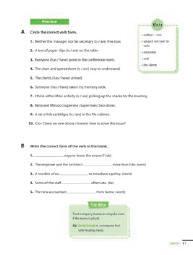



[
Reading Strategy ]
Information and examples for reading questions are provided. Students apply what they have learned to the practice activities.

[ Mini-Test ]
All seven sections of the TOEIC® are represented in a short test which consists of TOEIC® style questions. Detailed answer keys with explanations for each mini-test are available for download, in addition to a basic answer key provided at the back of the book.

TEST PREP
22 Mini-Test 1 A Listening: Photographs Listen and circle the letter of the statement that best describes the photograph. 1. (A) (B) (C) (D) (A) (B) (C) (D) 3. (A) (B) (C) (D) UNIT Vocabulary: Subject-Verb Homophones Reading Strategy: Main Idea 23 B Listening: Question-Response Listen to the question or statement and three responses. Circle the letter of the best 2. (A) (B) (C) (A) (B) (C) (A) (B) (C) 5. (A) (B) (C) (A) (B) (C) C Listening: Short Conversations 1. Why is the woman unhappy? She hates her new job. She has no colleagues. (C) She has no money for snack. (D) Her colleagues eat her snacks. Where does the woman keep her snacks? (A) On her colleague’s desk (B) In box (C) In her bag (D) On her desk 3. What does the man suggest? (A) (B) Stop taking snacks to work. (C) Put the snacks in a drawer. (D) Give snacks to her colleagues. UNIT 24 D Listening: Short Talks Listen and choose the best answer to each question. 1. What is the speaker talking about? A meeting room (B)A special meeting (C) (D) An important date Who should attend meetings? (A) Only managers (B)All staff members (C) The woman (D) Special guests What will happen to those who miss meeting? (A) Nothing will happen. (B)They must write on the calendar. (C) They will attend another meeting. (D) They will lose some pay. E Reading: Incomplete Sentences Choose the word or phrase that best completes the sentence. (A) delivers (B)supervises deliver There box of memory sticks on the table. (A) (B) (C) (D) has 3. No one the latest spreadsheets yet. (A) has seen (B)has scene (C) (D) Everyone at my office works in (A) file cabinets (B)paper shredders (C) cubicles (D) colleagues
25 a lot of money. (A) fix (B) (C) (D) deliver My suddenly went black. Now can’t see anything! (A) keyboard (B) clipboard (C) paper clip (D) monitor F Reading: Text Completion Choose the best word, phrase, or sentence for each blank. From: Erin Jeong Subject: Office Supplies all supplies. Please give your orders to him. So please give him your order forms by Thursday. Send him all orders by email. He will call you when the supplies are delivered. your supplies from the storeroom. you have any questions. 1. (A) (C) operates (D) manages 2. (A) He can place orders every day. (B) He will place orders every Friday. He can’t order paper or ink. (D) 3. (A) Pick up Manage (C) Operate (D) Send off 4. (A) supervise (B) know decide (D) UNIT 26 G Reading: Reading Comprehension The questions below refer to the following text message chain. Choose the best The meeting starts in five minutes. Where are you? Tim Ford Jon Clark Well, dropped coffee on my computer… had to take it to IT. need those spreadsheets. have my computer and the spreadsheets are on it. You always do this to me! OK, I’ll see you in the conference room. 1. What problem did Jon Clark have? He lost his computer. (B)He spilled a drink on his computer. (C) He forgot the spreadsheets. (D) He got stuck in the elevator. 2. What event will Jon and Tim attend? (B)Computer training (C) A meeting (D) A spreadsheet lesson 3. What is implied about Jon Clark? He often goes to meetings. (B)He is a good speaker. (C) He often makes Tim feel stressed. (D) He is a kind person. 65
DELTA’S KEY TO THE TOEFL iBT®

Delta’s Key to the TOEFL iBT®: Seven Practice Tests, Revised Edition will give students plenty of practice as they prepare for the Internet–based TOEFL iBT®. This book/audio package contains a concise introduction to the TOEFL® and the various question types, along with SEVEN full–length tests.

Seven Practice Tests can be used in a number of ways:
• As practice for taking the TOEFL iBT®
• As a companion to Delta’s Key to the TOEFL iBT®: Advanced Skill Practice
• As the primary or secondary text in a TOEFL® preparation course
• As a resource for independent study or laboratory
Features
• Description of the TOEFL iBT® form and content
• Sample questions in the four skill areas of reading, listening, speaking, and writing
• Seven full–length practice tests

• Nearly 700 questions in TOEFL® format















• Complete answer key and audio script
• Charts to record test scores and monitor progress
• Seven hours of audio in mp3 format








TEST PREP 66
Seed Learning Price List
• For titles with , CDs will be replaced by QR code links once stock runs out.
• の記載されたタイトルは在庫が無くなり次第、QRコード版へ移行します。
• For titles with ★, CDs will be replaced by QR code links once stock runs out, followed by a without Answer Key edition. The ISBNs will remain the same.
• ★の記載されたタイトルは在庫が無くなり次第、QRコード版へ、さらにAnswer Key付属無し版へ移行します。
• All prices include tax. ・価格は税込みです。
Millet / ジャン=フランソワ・ミレー
with
The Works of Paul Cézanne / ポール・セザンヌ Book with
The Works of Pierre-Auguste Renoir / ピエール=オーギュスト・ルノワール Book with Audio QR Code
Classic Art Readers Level 3
The Works of Edvard Munch / エドヴァルド・ムンク Book with Audio QR Code
The Works of Gustav Klimt / グスタフ・クリムト Book with Audio QR Code
The Works of Paul Gauguin / ポール・ゴーガン Book with Audio QR Code
The Works of Vincent van Gogh / フィンセント・ファン・ゴッホ Book with Audio QR Code
The Works of Wassily Kandinsky / ワリシー・カンディンスキー
Art Readers Level 4
The Works of Frida Kahlo / フリーダ・カーロ
The Works of Henri Matisse / アンリ・マティス
The Works of Marc Chagall / マルク・シャガール
The Works of Pablo Picasso / パブロ・ピカソ
The Works of Piet Mondrian / ピート・モンドリアン
with
with
1200 Key English Words 1 Student Book 9781946452863 ¥2,50856-57 1200 Key English Words 2 Student Book 9781946452870 ¥2,50856-57 1200 Key English Words 3 Student Book 9781946452887 ¥2,50856-57 4500 Key English Words 1 Student Book 9781944879969 ¥2,80558-59 4500 Key English Words 2 Student Book 9781944879976 ¥2,80558-59 4500 Key English Words 3 Student Book 9781944879983 ¥2,80558-59 4500 Key English Words 4 Student Book 9781944879990 ¥2,80558-59 7000 Key English Words 1 Student Book 9798886680584 TBA60-61 7000 Key English Words 2 Student Book 9798886680591 TBA60-61 7000 Key English Words 3 Student Book 9798886680607 TBA60-61 B Building TOEIC® Skills Student Book with Answer Key & MP3 CD 9781944879761 ¥3,520★ 64-65 C Classic Art Readers
The Works of Jean-François
Book with Audio QR Code 9798886680416 ¥1,67228-29 The Works of Johannes Vermeer / ヨハネス・フェルメール Book with Audio QR Code 9798886680409 ¥1,67228-29 The Works of Leonardo da Vinci / レオナルド・ダ・ヴィンチ Book with Audio QR Code 9798886680379 ¥1,67228-29 The Works of Michelangelo / ミケランジェロ Book with Audio QR Code 9798886680386 ¥1,67228-29 The Works of Rembrandt
Book with Audio QR Code 9798886680393 ¥1,67228-29 Classic Art Readers Level
The Works of Auguste
Book with Audio QR Code 9798886680430 ¥1,67228-29 The Works of Claude Monet
Book with Audio QR Code 9798886680447 ¥1,67228-29 The
9798886680423 ¥1,67228-29
Level 1
/ レンブラント
2
Rodin / オーギュスト・ロダン
/ クロード・モネ
Works of Edgar Degas / エドガー・ドガ Book
Audio QR Code
9798886680461 ¥1,67228-29
Audio QR Code
9798886680454
¥1,67228-29
9798886680508
¥1,67228-29
9798886680492
¥1,67228-29
9798886680478
¥1,67228-29
9798886680485
¥1,67228-29
Book
Audio
9798886680515 ¥1,67228-29
with
QR Code
Classic
Book
Audio QR Code 9798886680560 ¥1,67228-29
Book
Audio
9798886680522 ¥1,67228-29
Book
Audio QR
9798886680553 ¥1,67228-29
with
QR Code
with
Code
Book
Audio
9798886680546 ¥1,67228-29
9798886680539 ¥1,67228-29 Classic
Book
Audio
9784909362483 ¥31,79028-29 Completing
Student Book with Audio QR Code 9781946452917 ¥3,52064-65 Title ISBN Price Page 67
QR Code
Book with Audio QR Code
Art Readers Full Title Pack
with
QR Code (20 titles)
TOEIC® Skills
Seed Learning Price List
Culture Readers: Foods Level 1
Foods from India / インドの食べ物 Book with Audio QR Code
Foods from Italy / イタリアの食べ物 Book with Audio QR Code
Foods from Mexico / メキシコの食べ物 Book with Audio QR Code
Foods from South Korea / 韓国の食べ物 Book with Audio QR Code
Foods from Spain / スペインの食べ物 Book with Audio QR Code
Culture Readers: Foods Level 2
Foods from China / 中国の食べ物 Book with Audio QR Code
Foods from England / イングランドの食べ物 Book with Audio QR Code
Foods from France / フランスの食べ物 Book with Audio QR Code
Foods from South Africa / 南アフリカの食べ物 Book with Audio QR Code
Foods from the United States / アメリカの食べ物 Book with Audio QR Code
Culture Readers: Foods Level 3
Foods from Germany / ドイツの食べ物 Book with Audio QR Code
Foods from Japan / 日本の食べ物 Book with Audio QR Code
Foods from Morocco / モロッコの食べ物 Book with Audio QR Code
Foods from Thailand / タイの食べ物 Book with Audio QR Code
Foods from Turkey / トルコの食べ物 Book with Audio QR Code
Culture Readers: Foods Level 4
Foods from Australia / オーストラリアの食べ物 Book with Audio QR Code
Foods from Greece / ギリシャの食べ物 Book with Audio QR Code
Foods from Russia / ロシアの食べ物 Book with Audio QR Code
Foods from Vietnam / ベトナムの食べ物 Book with Audio QR Code
世界各地のお正月
St. Patrick's Day / アイルランドの祝日 セント・パトリックス・デー
The Lantern Festival / ランタンフェスティバル
Culture Readers: Holidays Level 3
Eid al-Fitr / イスラム教の祝日 イード・アル=フィトル
Ice Festivals / 世界のアイスフェスティバル
Oktoberfest / オクトーバーフェスト
The Dragon Boat Festival / ドラゴンボートフェスティバル
Culture Readers: Holidays Level 4
/ 二つのカーニバル
Guy Fawkes Day / ガイ・フォークス・デー
Hanukkah / ユダヤ教のお祭り ハヌカ
¥1,67222-23
¥1,67222-23
¥1,67222-23
¥1,67222-23
¥1,67222-23
¥1,67222-23
¥1,67222-23
¥1,67222-23
¥1,67222-23
¥1,67222-23
¥1,67222-23
¥1,67222-23
9781953705594 ¥1,67222-23
9781953705600 ¥1,67222-23
9781953705617 ¥1,67222-23
9781953705624 ¥1,67222-23
9781953705471
9781953705488
9781953705501
9781953705495
9781953705518
9781953705532
9781953705549
9781953705556
9781953705563
9781953705525
9781953705570
9781953705587
9781953705631
Foods from Brazil / ブラジルの食べ物 Book with Audio QR Code
¥1,67222-23
9781953705648
¥1,67222-23
9781953705655
¥1,67222-23
9781953705662 ¥1,67222-23 Culture Readers: Foods Full Title Pack Book with Audio QR Code (20 titles) 9784909362414 ¥31,79022-23 Culture Readers: Holidays Level 1 Chinese New Year / 春節 (旧正月) Book with Audio QR Code 9781951423018 ¥1,67224-25 Easter / イースター Book with Audio QR Code 9781951423025 ¥1,67224-25 La Tomatina / スペインのトマト祭り Book with Audio QR Code 9781951423032 ¥1,67224-25 Thanksgiving Day / 感謝祭 Book with Audio QR Code 9781951423049 ¥1,67224-25 Valentine's Day / バレンタインデー Book with Audio QR Code 9781951423001 ¥1,67224-25 Culture Readers: Holidays
Halloween / ハロウィン Book with Audio QR Code 9781951423094 ¥1,67224-25 Holi / ヒンドゥー教の春祭り
Book with Audio QR Code 9781951423056 ¥1,67224-25
Book
Audio QR Code 9781951423070 ¥1,67224-25
Level 2
ホーリー祭
New Year's Day /
with
Book
9781951423087 ¥1,67224-25
with Audio QR Code
9781951423063 ¥1,67224-25
Book
Audio
Code 9781951423131 ¥1,67224-25
Book
Audio
Code 9781951423100 ¥1,67224-25
Book
9781951423148
Book with Audio QR Code
Christmas / クリスマス
with
QR
with
QR
with Audio QR Code
¥1,67224-25
Book
9781951423124
Book
Audio
9781951423117
with Audio QR Code
¥1,67224-25
with
QR Code
¥1,67224-25
Book
Audio
9781951423179 ¥1,67224-25
Book
Audio
9781951423155 ¥1,67224-25
Book with Audio QR Code 9781951423193 ¥1,67224-25 Title ISBN Price Page 68
Carnival
with
QR Code
with
QR Code
Songkran / タイの旧正月 ソンクラーン Book with Audio QR Code 9781951423186 ¥1,67224-25 The Naadam Festival / モンゴル最大の祭典 ナーダム Book with Audio QR Code 9781951423162 ¥1,67224-25 Culture Readers: Holidays Full Title Pack Book with Audio QR Code (20 titles) 9784909362292 ¥31,79024-25 D Delta's Key to the TOEFL iBT® Student Book with MP3 CD 9781621670957 ¥5,39066 Developing TOEIC® Skills Student Book with Answer Key & MP3 CD 9781944879778 ¥3,520★ 64-65 E Early Listeners 1 Student Book with Workbook, Transcripts & AK, Audio QR Code 9781951423643 ¥3,52040-41 Early Listeners 2 Student Book with Workbook, Transcripts & AK, Audio QR Code 9781951423650 ¥3,52040-41 Early Listeners 3 Student Book with Workbook, Transcripts & AK, Audio QR Code 9781951423667 ¥3,52040-41 Early Writers 1 Student Book with Workbook & Audio QR Code 9798886680058 ¥3,08036-37 Early Writers 2 Student Book with Workbook & Audio QR Code 9798886680065 ¥3,08036-37 Early Writers 3 Student Book with Workbook & Audio QR Code 9798886680072 ¥3,08036-37 Easy Fun Facts 1 Student Book with Workbook & Audio CD 9781944879938 ¥2,750 14-15 Student Book with Workbook & Audio QR Code 9781943980833 ¥2,75014-15 Easy Fun Facts 2 Student Book with Workbook & Audio QR Code 9781943980840 ¥2,75014-15 Easy Fun Facts 3 Student Book with Workbook & Audio QR Code 9781943980857 ¥2,75014-15 Easy Fun Reading 1 Student Book with Workbook & Audio QR Code 9781943980802 ¥2,75010-11 Easy Fun Reading 2 Student Book with Workbook & Audio CD 9781944879860 ¥2,750 10-11 Student Book with Workbook & Audio QR Code 9781943980819 ¥2,75010-11 Easy Fun Reading 3 Student Book with Workbook & Audio QR Code 9781943980826 ¥2,75010-11 Easy Speaking for Speeches 1 Student Book with Portfolio, Audio & Video QR Code 9781951423964 ¥3,30048-49 Easy Speaking for Speeches 2 Student Book with Portfolio, Audio & Video QR Code 9781951423971 ¥3,30048-49 Easy Speaking for Speeches 3 Student Book with Portfolio, Audio & Video QR Code 9781951423988 ¥3,30048-49 EIKEN NAVI: GRADE 3 Student Book 9784991017223 ¥1,87062-63 F Fast Track 1 Student Book with Study Book 9781943980628 ¥3,1908-9 Fast Track 2 Student Book with Study Book 9781943980635 ¥3,1908-9 Fast Track 3 Student Book with Study Book 9781943980642 ¥3,1908-9 Fun Facts 1 Student Book with Workbook & Audio QR Code 9781943980680 ¥2,75016-17 Fun Facts 2 Student Book with Workbook & Audio QR Code 9781943980697 ¥2,75016-17 Fun Facts 3 Student Book with Workbook & Audio CD 9781944879846 ¥2,750 16-17 Student Book with Workbook & Audio QR Code 9781943980703 ¥2,75016-17 Fun Reading 1 Student Book with Workbook & Audio QR Code 9781943980659 ¥2,75012-13 Fun Reading 2 Student Book with Workbook & Audio CD 9781944879808 ¥2,750 12-13 Student Book with Workbook & Audio QR Code 9781943980666 ¥2,75012-13 Fun Reading 3 Student Book with Workbook & Audio CD 9781944879815 ¥2,750 12-13 Student Book with Workbook & Audio QR Code 9781943980673 ¥2,75012-13 Future Jobs Readers Level 1 Asset Managers / アセットマネージャー Book with Audio CD 9781943980376 ¥1,485 26-27 Cyber Security Experts / サイバーセキュリティ専門家 Book with Audio CD 9781943980390 ¥1,485 26-27 Medical Scientists / メディカルサイエンティスト Book with Audio CD 9781943980352 ¥1,485 26-27 Robotics Engineers / ロボットエンジニア Book with Audio CD 9781943980338 ¥1,485 26-27 Social Media Managers / ソーシャルメディアマネージャー Book with Audio CD 9781943980369 ¥1,485 26-27 Future Jobs Readers Level 2 App Developers / アプリケーション開発者 Book with Audio CD 9781943980345 ¥1,485 26-27 Computer Intelligence Engineers / コンピュータ知能技術者 Book with Audio CD 9781943980413 ¥1,485 26-27 Title ISBN Price Page 69
Seed Learning Price List
Seed Learning Price List
Digital Modelers / デジタルモデラー Book with Audio CD 9781943980437 ¥1,485 26-27 Drone Pilots / ドローンパイロット Book with Audio CD 9781943980383 ¥1,485 26-27 Wearable Technology Creators / ウェアラブル技術制作者 Book with Audio CD 9781943980406 ¥1,485 26-27 Future Jobs Readers Level 3 Data Miners / データマイナー Book with Audio CD 9781943980475 ¥1,485 26-27 Genetic Counselors / 遺伝カウンセラー Book with Audio CD 9781943980468 ¥1,485 26-27 IoT Marketing Specialists / IoTマーケティングスペシャリスト Book with Audio CD 9781943980420 ¥1,485 26-27 Space Pilots / スペースパイロット Book with Audio CD 9781943980444 ¥1,485 26-27 Water Harvesters / ウォーターハーベスター Book with Audio CD 9781943980451 ¥1,485 26-27 Future Jobs Readers Level 4 Agricultural Engineers / 農業エンジニア Book with Audio CD 9781943980512 ¥1,485 26-27 Database Administrators / データベースアドミニストレーター Book with Audio CD 9781943980482 ¥1,485 26-27 Intellectual Property Lawyers / 知的財産弁護士 Book with Audio CD 9781943980529 ¥1,485 26-27 Nanotechnology Research Scientists / ナノテクノロジー研究者 Book with Audio CD 9781943980499 ¥1,485 26-27 Quantum Computer Scientists / 量子コンピュータ科学者 Book with Audio CD 9781943980505 ¥1,485 26-27 Future Jobs Readers Full Pack Book with Audio CD (20 titles) 9784909362070 ¥28,160 26-27 G Good Listeners 1 Student Book with Workbook, Transcripts & AK, Audio QR Code 9781951423674 ¥3,57542-43 Good Listeners 2 Student Book with Workbook, Transcripts & AK, Audio QR Code 9781951423681 ¥3,57542-43 Good Listeners 3 Student Book with Workbook, Transcripts & AK, Audio QR Code 9781951423698 ¥3,57542-43 Good Writers 1 Student Book with Workbook 9798886680089 ¥3,08038-39 Good Writers 2 Student Book with Workbook 9798886680096 ¥3,08038-39 Good Writers 3 Student Book with Workbook 9798886680102 ¥3,08038-39 H Happy Grammar 1 Student Book with Workbook 9781946452825 ¥2,50854-55 Happy Grammar 2 Student Book with Workbook 9781946452832 ¥2,50854-55 Happy Grammar 3 Student Book with Workbook 9781946452849 ¥2,50854-55 Happy Grammar 4 Student Book with Workbook 9781946452856 ¥2,50854-55 I Intensive Listening Training 1 Student Book with MP 3 CD 9781946452719 ¥2,310 46-47 Intensive Listening Training 2 Student Book with MP 3 CD 9781946452726 ¥2,310 46-47 Intensive Listening Training 3 Student Book with MP 3 CD 9781946452931 ¥2,310 46-47 M Mastering TOEIC® Skills Student Book with Answer Key & MP3 CD 9781944879785 ¥3,520★ 64-65 R Reading for the Academic World 1 Student Book with MP3 CD 9781946452795 ¥2,530 20-21 Reading for the Academic World 2 Student Book with MP3 CD 9781946452801 ¥2,530 20-21 Student Book with Audio QR Code 9781970046038 ¥2,53020-21 Reading for the Academic World 3 Student Book with MP3 CD 9781946452818 ¥2,530 20-21 Student Book with Audio QR Code 9781970046045 ¥2,53020-21 S Smart Listeners 1 Student Book with Workbook, Transcripts & AK, Audio QR Code 9781951423704 ¥3,30044-45 Smart Listeners 2 Student Book with Workbook, Transcripts & AK, Audio QR Code 9781951423711 ¥3,30044-45 Smart Listeners 3 Student Book with Workbook, Transcripts & AK, Audio QR Code 9781951423728 ¥3,30044-45 Speaking for Presentations 1 Student Book with Audio QR Code 9781946452894 ¥2,80552-53 Speaking for Presentations 2 Student Book with Audio QR Code 9781946452900 ¥2,80552-53 Speaking for Speeches 1 Student Book with Audio QR Code 9781943980925 ¥2,915Title ISBN Price Page 70
Seed Learning Price List Speaking for Speeches 2 Student Book with Audio QR Code 9781943980932 ¥2,915Speaking for Speeches 3 Student Book with MP3 CD 9781946452665 ¥2,915Student Book with Audio QR Code 9781943980949 ¥2,915Speaking for Speeches Second Edition 1 Student Book with Audio QR Code 9798886680140 ¥3,30050-51 Speaking for Speeches Second Edition 2 Student Book with Audio QR Code 9798886680157 ¥3,30050-51 Speaking for Speeches Second Edition 3 Student Book with Audio QR Code 9798886680164 ¥3,30050-51 T Timed Reading for Fluency 1 Student Book 9781946452672 ¥2,53018-19 Timed Reading for Fluency 2 Student Book 9781946452689 ¥2,53018-19 Timed Reading for Fluency 3 Student Book 9781946452696 ¥2,53018-19 Timed Reading for Fluency 4 Student Book 9781946452702 ¥2,53018-19 Top Kids 1 Student Book with MP3 CD 9781944879648 ¥2,7506-7 Workbook 9781944879709 ¥1,2106-7 Top Kids 2 Student Book with MP3 CD 9781944879655 ¥2,7506-7 Workbook 9781944879716 ¥1,2106-7 Top Kids 3 Student Book with MP3 CD 9781944879662 ¥2,7506-7 Workbook 9781944879723 ¥1,2106-7 Top Kids 4 Student Book with MP3 CD 9781944879679 ¥2,7506-7 Workbook 9781944879730 ¥1,2106-7 Top Kids 5 Student Book with MP3 CD 9781944879686 ¥2,7506-7 Workbook 9781944879747 ¥1,2106-7 Top Kids 6 Student Book with MP3 CD 9781944879693 ¥2,7506-7 Workbook 9781944879754 ¥1,2106-7 Top Phonics 1 Student Book with Audio QR Code 9781943980864 ¥2,4974-5 Workbook 9781944879198 ¥1,1004-5 Top Phonics Readers 1: Lots of Lemons 9781946452733 ¥1,2654-5 Top Phonics 2 Student Book with Audio QR Code 9781943980871 ¥2,4974-5 Workbook 9781944879204 ¥1,1004-5 Top Phonics Readers 2: The Red Jet 9781946452740 ¥1,2654-5 Top Phonics 3 Student Book with Audio QR Code 9781943980888 ¥2,4974-5 Workbook 9781944879211 ¥1,1004-5 Top Phonics Readers 3: The Cube 9781946452757 ¥1,2654-5 Top Phonics 4 Student Book with Hybrid CD(Audio CD & CD ROM) 9781943980154 ¥2,497 4-5 Student Book with Audio QR Code 9781943980895 ¥2,4974-5 Workbook 9781944879228 ¥1,1004-5 Top Phonics Readers 4: To the Shop! 9781946452764 ¥1,2654-5 Top Phonics 5 Student Book with Hybrid CD(Audio CD & CD ROM) 9781943980161 ¥2,497 4-5 Student Book with Audio QR Code 9781943980901 ¥2,4974-5 Workbook 9781944879235 ¥1,1004-5 Top Phonics Readers 5: When They Are Big 9781946452771 ¥1,2654-5 Top Phonics 6 Student Book with MP3 CD 9781946452634 ¥2,497 4-5 Student Book with Audio QR Code 9781943980918 ¥2,4974-5 Workbook 9781946452788 ¥1,1004-5 W World History Readers Level 1 Calendars and the History of Time / 暦の歴史 Book with Audio CD 9781946452009 ¥1,485 30-33 Great Wall of China, The / 万里の長城 Book with Audio CD 9781946452139 ¥1,485 30-33 Title ISBN Price Page 71
Seed Learning Price List
/ アメリカ合衆国の誕生
da Vinci / マルチ・タレントのレオナルド・ダ・ヴィンチ
Death in Ancient Egypt / 古代エジプトにおける生と死
Invention of Writing, The / 文字の変遷 Book with Audio CD 9781946452054 ¥1,485 30-33 Magic of Numbers, The / 数の不思議 Book with Audio CD 9781946452115 ¥1,485 30-33 Making of a United Europe, The / 欧州連合への道 Book with Audio CD 9781946452108 ¥1,485 30-33 Persian Empire, The / ペルシア帝国 Book with Audio CD 9781946452085 ¥1,485 30-33 Pilgrim Fathers, The / ピルグリム・ファーザーズ Book with Audio CD 9781946452030 ¥1,485 30-33 Searching for El Dorado / エル・ドラドを探して Book with Audio CD 9781946452016 ¥1,485 30-33 Tower of Babel, The / バベルの塔 Book with Audio CD 9781946452023 ¥1,485 30-33 Traveling on the Silk Road / シルク・ロードを旅して Book with Audio CD 9781946452047 ¥1,485 30-33 World History Readers 1 Pack Book with Audio CD (10 titles) 9784904568941 ¥14,080 30-33 World History Readers Level 2 Agricultural Revolution, The / 農業革命 Book with Audio CD 9781946452122 ¥1,485 30-33 British Empire, Then and Now, The / 大英帝国今昔物語 Book with Audio QR Code 9781946452160 ¥1,485 30-33 History of Printing, The / 印刷の歴史 Book with Audio CD 9781946452238 ¥1,485 30-33 Industrial Revolution, The / 産業革命 Book with Audio CD 9781946452092 ¥1,485 30-33 Neo-Assyrian Empire, The / 新アッシリア時代 Book with Audio CD 9781946452177 ¥1,485 30-33 Ottomans and Their Empire, The / オスマン・トルコ Book with Audio CD 9781946452061 ¥1,485 30-33 Rise and Fall of Communism, The / 共産主義の勃興と凋落 Book with Audio CD 9781946452191 ¥1,485 30-33 Vikings and Erik the Red, The / バイキングと赤毛のエイリーク Book with Audio CD 9781946452269 ¥1,485 30-33 War Between the States, The / 南北戦争 Book with Audio CD 9781946452078 ¥1,485 30-33 Wars in the Middle East / 中東戦争 Book with Audio QR Code 9781946452146 ¥1,485 30-33 World History Readers 2 Pack Book with Audio CD (10 titles) 9784904568958 ¥14,080 30-33 World History Readers Level 3 Battle of Salamis, The / サラミスの海戦 Book with Audio CD 9781946452290 ¥1,485 30-33 Benjamin Franklin / ベンジャミン・フランクリン Book with Audio CD 9781946452252 ¥1,485 30-33 Christopher Columbus / クリストファー・コロンブス Book with Audio CD 9781946452337 ¥1,485 30-33 Cleopatra / クレオパトラ Book with Audio CD 9781946452214 ¥1,485 30-33 French Revolution, The / フランス革命 Book with Audio CD 9781946452245 ¥1,485 30-33 Galileo Galilei / ガリレオ・ガリレイの数奇な人生 Book with Audio CD 9781946452283 ¥1,485 30-33 Space Exploration / 宇宙開発の歴史 Book with Audio CD 9781946452153 ¥1,485 30-33 Spanish Conquest of the Americas, The / スペイン帝国によるラテンアメリカ征服 Book with Audio CD 9781946452207 ¥1,485 30-33 Tea and Wars / お茶を巡る二つの戦争 Book with Audio CD 9781946452184 ¥1,485 30-33 Trojan War, The / トロイア戦争 Book with Audio CD 9781946452344 ¥1,485 30-33 World History Readers 3 Pack Book with Audio CD (10 titles) 9784904568965 ¥14,080 30-33 World History Readers Level 4 Alexander the Great / アレクサンダー大王 Book with Audio CD 9781946452306 ¥1,485 30-33 Birth
Book with Audio CD 9781946452276 ¥1,485 30-33 Crusades, The / 十字軍 Book with Audio CD 9781946452368 ¥1,485 30-33 Genghis Khan /
Book with Audio CD 9781946452399 ¥1,485 30-33 Great Plane Race, The
飛行機開発競争 Book with Audio CD 9781946452382 ¥1,485 30-33 Korea: A
Book with Audio CD 9781946452405 ¥1,485 30-33 Leonardo
Book with Audio CD 9781946452313 ¥1,485 30-33
and
Book with Audio CD 9781946452221 ¥1,485 30-33 Life
Book with Audio CD 9781946452375 ¥1,485 30-33 Neo-Babylonian
Book with Audio CD 9781946452320 ¥1,485 30-33 World History Readers 4 Pack Book with Audio CD (10 titles) 9784904568972 ¥14,080 30-33 Title ISBN Price Page 72
of the United States of America, The
チンギス・ハン
/
Land Divided by War / 韓国:引き裂かれた祖国
Life
in the Roman Army / 古代ローマ軍での生活
Empire, The / 新バビロニア帝国
World History Readers Level 5 China: The New Superpower / 新興超大国中国 Book with Audio CD 9781946452481 ¥1,485 30-33 Decisive Battles of World War II / 第二次世界大戦における決戦 Book with Audio CD 9781946452474 ¥1,485 30-33 Great Depression, The / 世界大恐慌 Book with Audio CD 9781946452498 ¥1,485 30-33 Great Plague, The / ペスト大流行 Book with Audio CD 9781946452412 ¥1,485 30-33 Medical Revolution, The / 医療革命 Book with Audio CD 9781946452351 ¥1,485 30-33 Mughal Empire, The / ムガル帝国 Book with Audio CD 9781946452429 ¥1,485 30-33 Popes and Kings in the Middle Ages / 中世ヨーロッパの教皇と王 Book with Audio CD 9781946452436 ¥1,485 30-33 Story of the Reformation, The / 宗教改革 Book with Audio CD 9781946452450 ¥1,485 30-33 Story of the Renaissance, The / ルネサンス Book with Audio CD 9781946452467 ¥1,485 30-33 Tutankhamun / ツタンカーメン Book with Audio CD 9781946452443 ¥1,485 30-33 World History Readers 5 Pack Book with Audio CD (10 titles) 9784904568989 ¥14,080 30-33 World History Readers Level 6 Capitalism: Good or Evil? / 資本主義の歴史 善なる側面と悪なる側面 Book with Audio QR Code 9781946452580 ¥1,485 30-33 China’s First Empire: The Qin Dynasty / 秦の始皇帝と中国最初の帝国 Book with Audio CD 9781946452597 ¥1,485 30-33 Cold War, The / 冷戦 Book with Audio CD 9781946452535 ¥1,485 30-33 Communication Technology / コミュニケーションの歴史 Book with Audio QR Code 9781946452511 ¥1,485 30-33 First Democracies, The / 最初の民主主義 Book with Audio CD 9781946452528 ¥1,485 30-33 Global Trade and Peace / 世界貿易と平和 Book with Audio CD 9781946452542 ¥1,485 30-33 Greek Culture / 古代ギリシア人と現代の世界 Book with Audio CD 9781946452559 ¥1,485 30-33 History of Transportation, The / 交通機関の歴史 Book with Audio CD 9781946452573 ¥1,485 30-33 Napoleon / ナポレオン Book with Audio CD 9781946452566 ¥1,485 30-33 World War I / 第一次世界大戦 Book with Audio CD 9781946452504 ¥1,485 30-33 World History Readers 6 Pack Book with Audio CD (10 titles) 9784904568996 ¥14,080 30-33 World History Readers Full Pack Book with Audio CD (60 titles) 9784904568934 ¥80,300 30-33 Writing Time 1 Student Book with Workbook 9798886680614 TBA34-35 Writing Time 2 Student Book with Workbook 9798886680621 TBA34-35 Writing Time 3 Student Book with Workbook 9798886680638 TBA34-35 Title ISBN Price Page 73
Seed Learning Price List
Learn English with the World’s Best Videos!
Used by more than 2 million subscribers from over 120 countries worldwide.


QR codes provided on Seed Learning books
EnglishCentral is the leading provider of online English conversation solutions. The EnglishCentral platform combines the web’s best English videos, the proprietary IntelliSpeechSM assessment technology, an adaptive vocabulary learning system, and live tutors, delivered seamlessly over the web and on mobile devices.
Many Seed Learning books provide QR Codes on the back covers linking them to the EnglishCentral app.

74
4. You now have the textbook course in your account. Tap “Start.”


2. Type your email address. Tap “Continue with email.”

3a. If you already have an EnglishCentral account, enter your password.


3b. If you don’t have an EnglishCentral account, add your name, email, and password. Tap “Register now.”
5. Install the EnglishCentral app.



6. Tap “Sign in.” Sign in with the email address that you used in #2.
7. You will see your textbook course when you log in. Complete all the units to nish the course.
 1. Scan the QR code.
1. Scan the QR code.
商品についてのご質問は For general information
株式会社 トライアログ・エデュケーション
Tryalogue Education Co.,Ltd.


FAX : 03-6383-5992
E-mail : contact@tryalogue.co.jp
URL : www.tryalogue.co.jp
[書店・ブックセラー専用] 在庫お問い合わせとご注文は For booksellers only
発売元
株式会社三善
〒167-0032 東京都杉並区天沼2-2-3
TEL : 03-3398-9163
FAX : 03-3398-9170






















































































































































































































































































































































































































































































































































































































































































































































































































































































































































































































































































































































































































































































































































































































































































































































































































































 1. Scan the QR code.
1. Scan the QR code.
